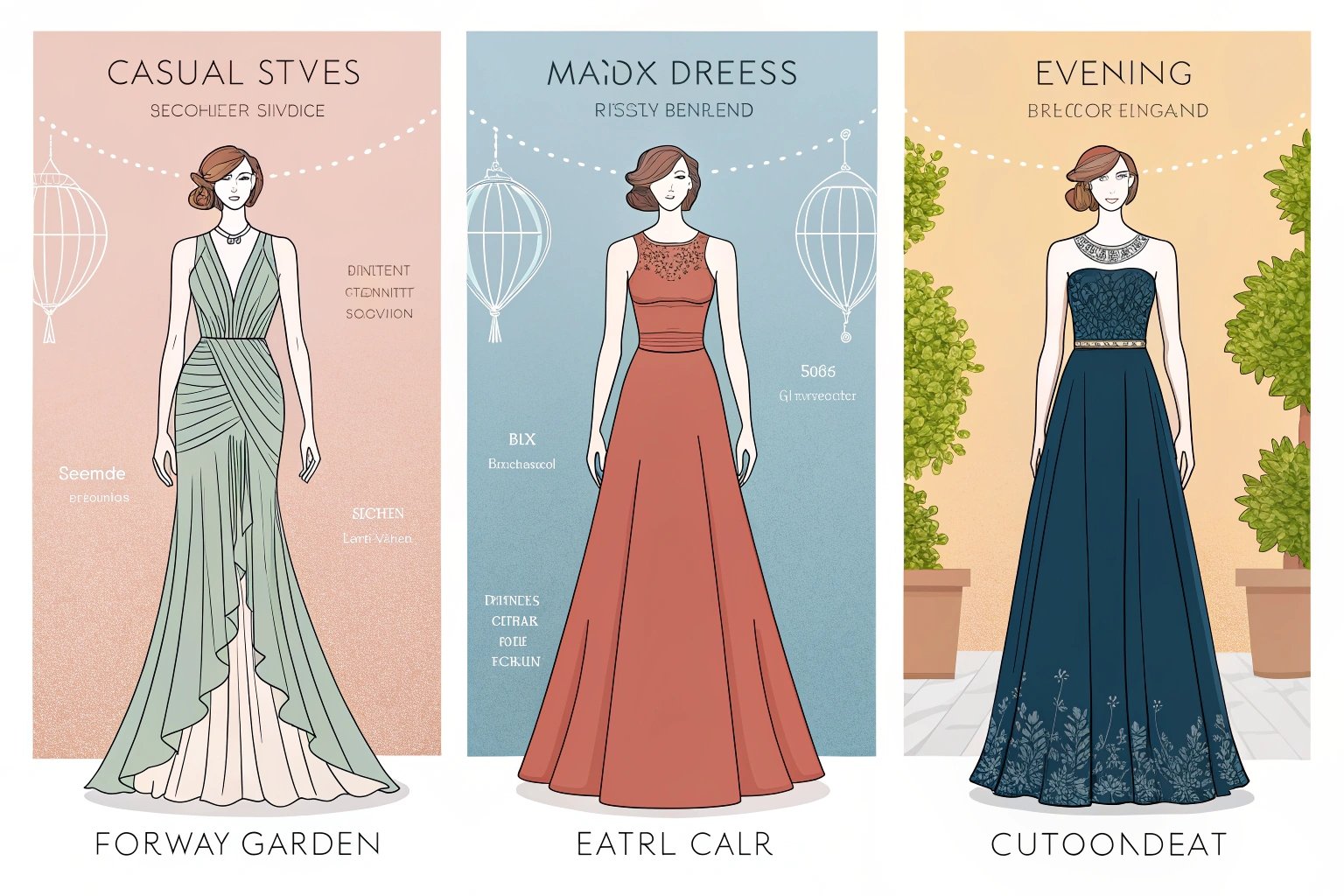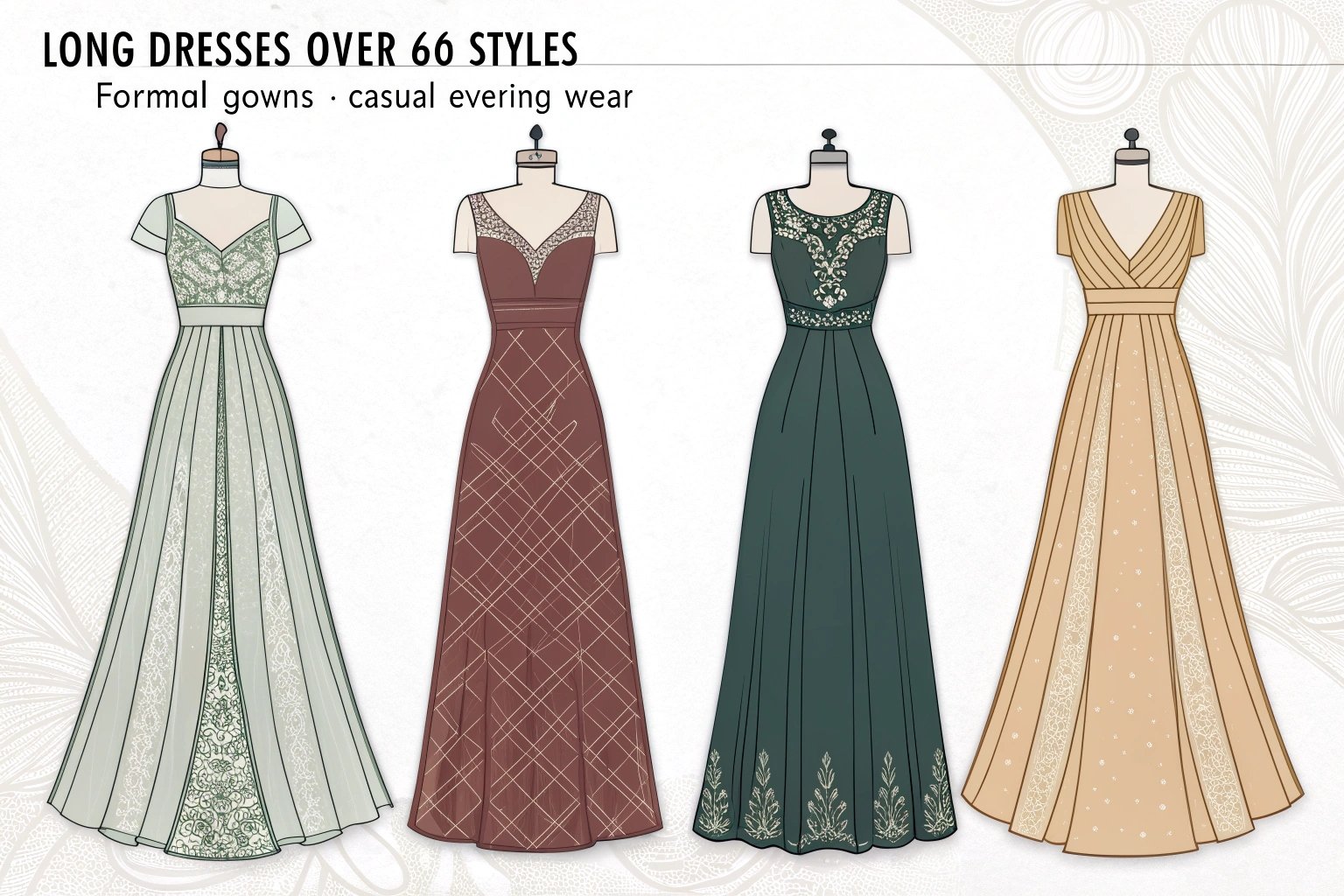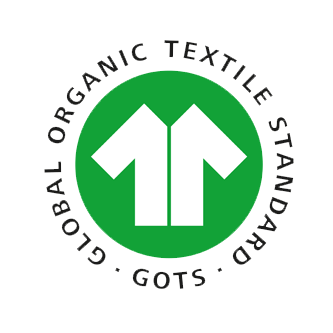A dress is more than just a garment—it’s a reflection of personality, era, and purpose.
There are over 80 recognized types of dresses in modern women’s fashion, each with a specific shape, use case, and visual impact. Understanding them helps consumers, designers, and buyers navigate style and market trends with confidence.
When I first entered the industry, clients often said they wanted “a wider variety of dress options.” But when we talked about “dresses,” our definitions often didn’t align. A client once requested a “slip dress,” but I delivered an A-line instead. Another asked for a “maxi,” but I created a tea-length version. I eventually realized that the word “dress” isn’t a single product category—it includes more than 80 defined styles, each with distinct meanings.
How are dress styles categorized in fashion design?
Dress styles are typically grouped by silhouette, length, neckline, construction, and intended use.
Categorization helps fashion professionals identify and communicate dress intent more clearly—from sketch to sample, and from lookbook to consumer-facing copy.
It’s not just about organizing styles—it’s about creating a shared language across design, sampling, buying, and production.
The five key ways to categorize dresses:
1. By Silhouette
| Style | Visual Feature | Suitable For |
|---|---|---|
| A-Line | Narrow at top, flares at hem | Universally flattering, casual or daily wear |
| Bodycon | Tight, figure-hugging | Nightlife, confident body types |
| Cocoon | Wide shoulders, tapered hem | Minimalist, fashion-forward markets |
| Empire | High waist just below bust | Maternity, vintage styles, broader hips |
2. By Length
- Mini Dress: Youthful, leg-revealing, party-ready
- Midi Dress: Practical elegance from knee to mid-calf
- Maxi Dress: Floor-length or ankle-skimming, ideal for formal or vacation looks
3. By Neckline
| Neckline Type | Common Styles | Style Direction |
|---|---|---|
| V-neck | Wrap Dress | Mature, face-framing |
| Off-Shoulder | Bardot Dress | Romantic, feminine |
| Square Neck | Cottagecore Dress | Vintage-inspired |
| High Neck | Sweater Dress | Minimal, autumn-winter vibe |
4. By Construction
- Pullover
- Zippered
- Halter
- Tank
5. By Occasion
| Occasion | Recommended Styles |
|---|---|
| Officewear | Shirt Dress, Wrap Dress, Shift Dress |
| Parties/Night Out | Slip Dress, Bodycon, Asymmetrical Dress |
| Travel/Vacation | Maxi Dress, Tiered Dress, Kaftan |
| Wedding Guest | Ruffle Dress, Fit & Flare, Mermaid Dress |
To truly understand dresses, you need more than creativity—you need systematic classification.
Why are silhouettes the foundation of dress understanding?
Silhouette determines the structure, emotion, and message behind every dress.
The silhouette sets the first visual impression—it affects styling, body fit, fabric choice, and brand narrative. It is the most strategic decision in the entire dress design process.
Silhouette is like the skeleton of a dress—it defines how the design feels and how the wearer is perceived.
Breakdown of Key Silhouettes and Their Strategic Value:
1. A-Line Dress
- Look: Fitted at top, flares naturally
- Advantage: Universally flattering, ideal for mass production
- Brand Use: Basics, workwear, preppy styles
2. Bodycon Dress
- Look: Clings to body curves
- Advantage: Sexy, perfect for nightwear
- Production Notes: Needs high-stretch fabrics, precise tailoring
3. Fit & Flare Dress
- Look: Cinched waist, full skirt
- Advantage: Flatters most body types
- Best For: Weddings, holidays, spring/summer lines
4. Sheath Dress
- Look: Straight-line, semi-fitted
- Style: Minimal, professional
- Common Fabrics: Cotton blends, knits, lined wovens
5. Empire Waist Dress
- Look: High waistline under bust
- Functionality: Maternity-friendly, figure-skimming
- Associated Styles: Victorian, Lolita, romantic wear
When the silhouette is right, half the design is already successful.
A-Line Dress
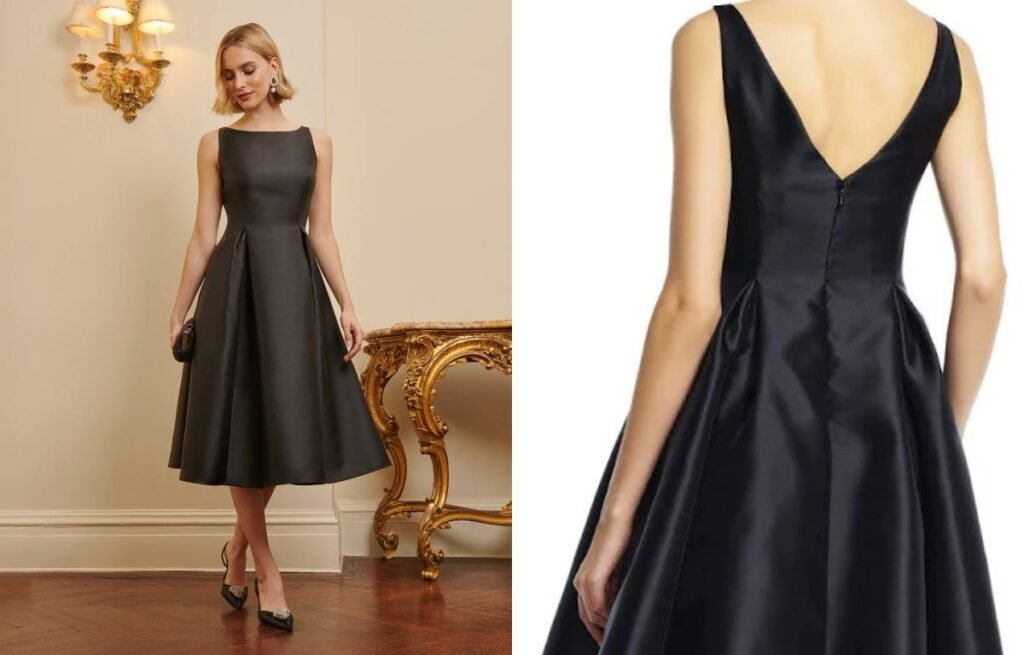
The A-Line Dress is one of the most universally flattering dress styles in women’s fashion. It suits all ages, body types, and occasions.
This dress is fitted at the top and gradually flares out from the waist, forming an “A” shape—hence the name. It’s known for its clean silhouette, ease of wear, and timeless appeal.
The first time I helped source A-line dresses for a client’s spring collection, the response was instant—it’s the kind of shape that never goes out of style.
Why is the A-Line Dress a wardrobe essential?
The A-line dress has remained a go-to for decades—and with good reason.
It’s versatile, flattering, and easy to style. Whether it’s a casual cotton day dress or a structured evening piece, the A-line flatters most figures while remaining effortlessly chic.
What Makes the A-Line Dress So Enduring?
There’s a reason this silhouette has stood the test of time—it blends form, function, and style in a uniquely balanced way.
Flattering for All Body Shapes:
The gradual flare from the waist creates the illusion of a balanced proportion. It smooths over the hips and thighs while defining the waist, making it ideal for pear-shaped, hourglass, or apple body types. Even for straight or athletic frames, it adds subtle femininity.
Adapts to Many Occasions:
A-line dresses can be worn to the office, casual brunches, weddings, or even formal events, depending on the fabric and detailing. A cotton A-line dress with a belt gives a casual vibe, while one in satin or crepe can be elevated for more elegant settings.
Variety in Design Elements:
Though the silhouette is consistent, the neckline, sleeve, and hemline variations are nearly endless—making this dress adaptable to trends. From cap sleeves to off-shoulder styles, from midi lengths to mini versions, designers can reinvent the A-line over and over.
Balance of Structure and Movement:
The flared bottom allows for ease of movement without compromising structure. This makes it more comfortable than bodycon silhouettes, yet more defined than flowy bohemian shapes. That perfect middle ground is what keeps it timeless.
Ideal for Layering and Styling:
A-line dresses pair well with cardigans, blazers, denim jackets, or even turtlenecks underneath in colder seasons. They also work across footwear—sneakers, heels, boots, or flats—giving them year-round styling potential.
A-Line vs. Other Dress Shapes:
| Feature | A-Line Dress | Shift Dress | Bodycon Dress |
|---|---|---|---|
| Fit at waist | Fitted then flared | Loose, no waist emphasis | Tight all over |
| Comfort level | High | Very high | Low (due to tightness) |
| Flattery for curves | Enhances naturally | Minimizes curves | Highlights curves |
| Occasion flexibility | Very versatile | Casual | Night-out/formal |
Best Fabrics for A-Line Dresses
Depending on the use and season, A-line dresses can be crafted from various materials:
- Cotton & Poplin: Great for everyday wear.
- Linen: Perfect for warm weather and resort looks.
- Crepe, Satin, or Chiffon: Ideal for formal and evening versions.
- Denim or Twill: For structured, casual variations.
Sheath Dress

It looks simple, yet it never goes out of style.
A sheath dress is a slim, straight-cut dress that closely follows the body’s natural lines without flaring or cinching. Known for its clean seams and polished silhouette, it’s one of the most adaptable and timeless styles in a woman’s wardrobe.
What makes the sheath dress so flattering and versatile?
Why does this silhouette work for so many women?
The sheath dress highlights the body without exaggerating curves, offering a clean, elongated shape. With the right cut and fabric, it can suit a wide range of body types and occasions.
How does the sheath dress work across different body types and situations?
The beauty of the sheath dress is how it combines structure and softness.
Body Shape Compatibility
Though fitted, the sheath dress doesn’t require dramatic curves. Thoughtful details and fabric selection allow it to flatter various figures:
- Hourglass: Accentuates natural curves. Look for defined waistlines.
- Rectangle: Choose styles with darts or princess seams to create curves.
- Apple: Opt for forgiving, stretchy fabrics that gently skim the body.
- Pear: Balance proportions with slightly looser skirts or darker colors on the bottom.
Adaptability to Different Occasions
While it’s best known as office wear, the sheath dress easily transforms depending on fabric and styling. Occasion Suggested Fabrics Styling Tips Office/Interview Ponte knit, wool blends Blazer, subtle accessories Cocktail/Evening Satin, silk, lace Belt, statement earrings, heels Daytime/Brunch Cotton blends, denim, knit Pair with flats and a simple handbag Wedding/Events Silk-linen, luxe jersey Printed or colorful versions work well
The Power of Fabric Choice
The comfort and fit of a sheath dress often come down to fabric. The ideal material should have enough structure to shape the body, but enough give to remain comfortable.
- Ponte Knit: Durable, stretchy, and ideal for everyday wear
- Double Knit: Cozy and sculpting, perfect for cooler months
- Silk/Satin: Adds elegance and drape, ideal for formalwear
- Wool Blends: Polished and warm, great for the office
Design Details That Elevate the Look
While the shape is classic, small details define its personality:
- Back slits: Offer ease of movement and subtle allure
- Necklines (crew, V-neck, boat): Alter the mood of the dress
- Zippers (usually back): Ease of wear with clean lines
- Waist accents (pleats, seams, belts): Add shape or style focus
Shif t Dress
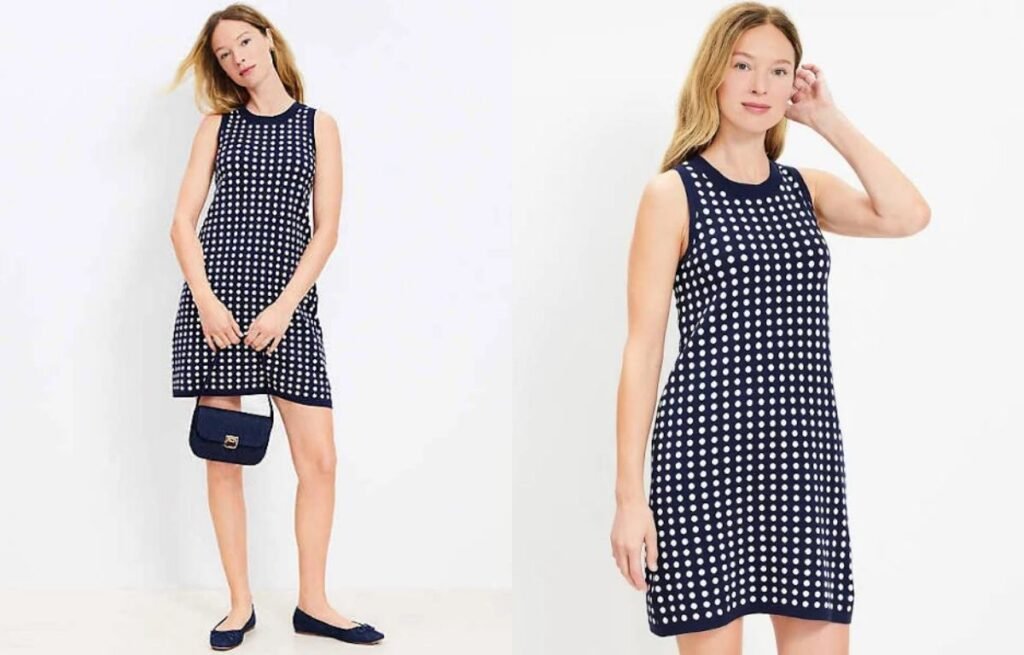
Simple, straight, and effortlessly chic—the shift dress never goes out of style.
A shift dress is a loose-fitting dress with straight lines that hangs down from the shoulders and doesn’t hug the waist. Its clean silhouette makes it comfortable, versatile, and universally flattering, especially for casual or semi-formal settings.
Why has the shift dress remained popular for decades?
The shift dress offers easy elegance and broad appeal across age groups and body types.
Its timeless design, comfort, and ability to transition from day to night have kept the shift dress relevant since the 1960s. Whether styled with flats for a casual look or heels for an office-ready outfit, it delivers a refined silhouette with minimal fuss.
Understanding the Enduring Appeal of the Shift Dress
The shift dress may look simple, but its impact and versatility are anything but. Here’s a closer look at why it continues to dominate fashion across decades:
1. Origins and Historical Influence
The shift dress rose to popularity in the 1960s, embraced by fashion icons like Audrey Hepburn and Jackie Kennedy. It reflected the modern woman’s lifestyle—free, mobile, and unfussy. Its straight silhouette was a rebellion against the tight-fitted, waist-cinched dresses of the 1950s. That cultural shift gave the dress its name—representing a “shift” in both fashion and societal roles.
2. Shape and Silhouette
Unlike bodycon or fit-and-flare dresses, the shift dress doesn’t define the waist or cling to curves. Its straight-line shape makes it a go-to for:
- Rectangular body shapes (adds subtle volume and structure),
- Apple-shaped bodies (skims the midsection),
- And petite frames (creates vertical length with minimal bulk).
That relaxed fit also adds breathability, which is ideal for warmer climates or layered looks in transitional seasons.
3. Versatility in Styling
One of the strongest points of the shift dress is how easily it adapts. You can layer it under a blazer for a corporate look or pair it with a denim jacket for a weekend outfit. Some brands design shift dresses with back darts or soft pleats to add shape, but the essence remains minimalist.
Key style pairings:
- Workwear: Add pumps and a structured handbag
- Casual: Pair with sneakers and crossbody bag
- Evening: Elevate with bold accessories and statement heels
4. Fabric and Texture Choices
The shift dress transforms dramatically based on fabric. Cotton and linen give it a laid-back feel, while crepe, satin, or ponte knit elevate it for more polished or occasion-ready looks.
| Fabric | Look & Feel | Best Use Cases |
|---|---|---|
| Cotton/Linen | Casual, breathable | Daywear, summer looks |
| Crepe/Satin | Soft, flowy, polished | Evening, formal events |
| Ponte/Rayon | Structured yet comfortable | Office wear, transitional seasons |
5. Modern Variations and Details
Contemporary shift dresses often feature updated details like:
- Bell or puffed sleeves
- High necklines or cut-outs
- Ruffled hems or color-blocking
- Zip backs or asymmetrical hems
These changes keep the silhouette fresh without changing its core identity.
Fit & Flare Dres
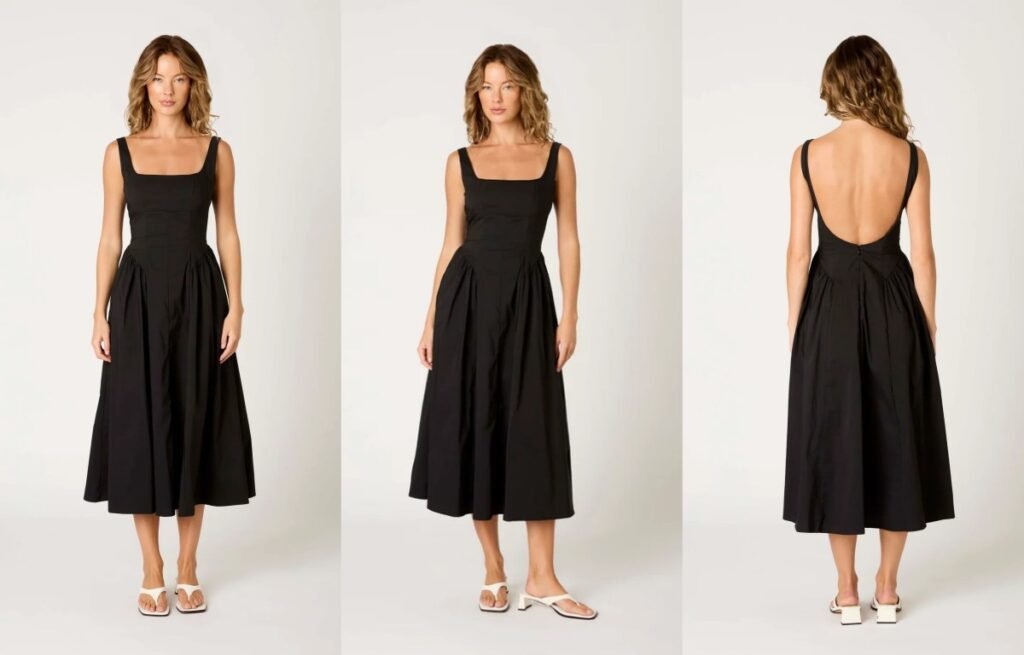
The fit & flare dress never goes out of style—it’s flattering, feminine, and easy to wear.
Defined by a fitted bodice and a flared skirt, this silhouette enhances the waist while offering ease and movement through the hips and legs. It’s one of the most versatile dress types for women of all ages and body shapes.
Why does the fit & flare dress work so well for so many body types?
This silhouette has stood the test of time because it creates balance and shape.
The fitted top highlights the upper body while the flared skirt softens the lower half, making it ideal for hourglass, pear, and even rectangle-shaped bodies.
Whether worn casually or dressed up, the fit & flare dress creates a flattering outline without needing much styling effort.
Exploring the Design, Function, and Appeal of the Fit & Flare Dress
The fit & flare dress is more than just flattering—it’s a masterclass in balanced design and versatility. Here’s a deeper look at why it works across fashion categories and body types:
1. Proportional Harmony
This dress is engineered to create visual symmetry. The narrow waist, emphasized by darts or a waistband, contrasts with the expanding flare of the skirt. This draws the eye inward at the waistline and outward at the hem, forming an hourglass illusion—even for those without naturally defined waists.
2. Fabric and Movement
One of the reasons this style feels so effortless is the way the flare adds flow and motion. Whether it’s made from cotton, chiffon, or ponte knit, the skirt’s movement brings grace and energy to each step. Stiffer fabrics give the skirt more volume and structure, while softer fabrics create a gentle sway.
Common fabric choices:
| Fabric Type | Effect on Silhouette |
|---|---|
| Ponte Knit | Structured and modern |
| Chiffon | Soft and romantic |
| Cotton Poplin | Crisp and casual |
| Satin | Elegant and fluid |
3. Styling Range
From weddings to workdays, the fit & flare can shift with ease. Pair it with flats and a cardigan for an office look, or heels and a belt for a formal setting. Because the silhouette does the styling work, accessories can remain minimal.
4. Inclusive and Confidence-Boosting
This silhouette provides coverage without hiding the figure. It gently skims over the hips and thighs, which many women prefer, while drawing attention to the waistline. It’s also an empowering style for postpartum, plus-size, or petite women who want to feel shaped without being squeezed.
5. Adaptable Variations
Designers often play with neckline (v-neck, scoop, sweetheart), sleeve type (cap, puff, long), and length (mini, midi, maxi) to suit seasonal trends and specific demographics.
Fit & Flare Variants:
- Formal: Full skirt, satin or crepe fabric, elegant neckline
- Casual: Knee-length, cotton or jersey fabric, short sleeves
- Retro-inspired: Bold prints, sweetheart neckline, cinched waist
- Modern minimalist: Solid colors, clean seams, sleeveless design
Best Occasions to Wear a Fit & Flare Dress
This dress shines across a wide range of events:
- Work: Neutral colors, structured fabric, knee-length cut
- Day outings: Printed or bright cotton versions
- Evening wear: Luxe fabric with a longer hemline and detail on the bodice
- Weddings: Whether you’re the guest or the bride (short reception dresses), it works
Bodycon Dress
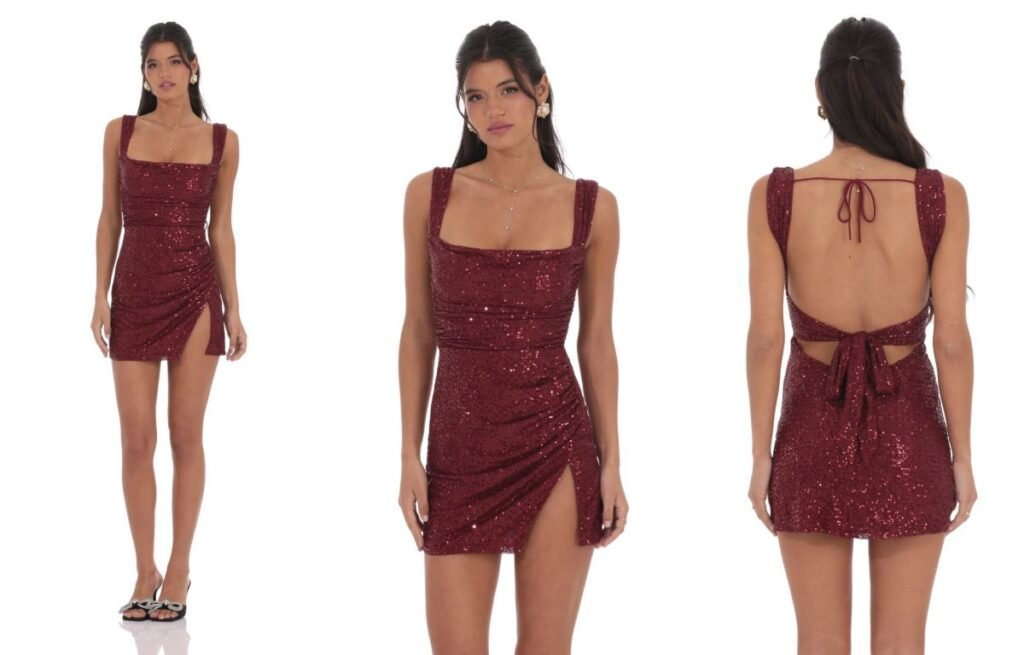
The bodycon dress is sleek, bold, and figure-hugging—it never goes unnoticed.
Bodycon, short for “body-conscious”, is a fitted dress that clings tightly to the body, highlighting the natural curves. It’s a go-to style for confident, contemporary looks—seen everywhere from nightclubs to red carpets.
Why does the bodycon dress remain so popular across trends?
Few dresses balance simplicity and boldness like the bodycon.
The bodycon dress stays relevant because it flatters curves, embraces body confidence, and adapts easily to both casual and formal settings. With fabric and cut changes, it fits Gen Z trends and classic wardrobes alike.
Understanding the Lasting Appeal of the Bodycon Dress
At first glance, the bodycon seems straightforward—tight and stretchy. But its enduring popularity lies in the subtleties of how it fits, flatters, and evolves with fashion.
Fit That Enhances Natural Shape
Unlike dresses that create volume, the bodycon works with your body’s natural lines. It’s designed to hug curves without gaps or extra structure. This close fit flatters hourglass, athletic, and petite body types alike—depending on styling and fabric choices.
Fabric Matters
Not all bodycon dresses are created equal. The best versions use high-quality, thick stretch fabrics that smooth and contour rather than cling too tightly. Popular materials include:
- Spandex blends: High elasticity, ideal for sleek, sculpted silhouettes
- Knitted jersey: Comfortable for casual looks
- Bandage fabric: Used in premium bodycon dresses, offering compression and support
Confidence-Driven Styling
Bodycon dresses symbolize confidence. Whether mini, midi, or full-length, they require minimal layering and rely on clean lines. Styling is often simple—pointed heels, sleek hair, and understated jewelry elevate the look.
Versatility Across Occasions
While bodycon dresses are often associated with nightlife or parties, newer variations make them wearable during the day. Ribbed cotton versions paired with sneakers work for casual brunches, while midi-length bodycons with sleeves suit business-casual settings when layered with a blazer.
Shifting Body Standards
The rise of body positivity movements has further solidified the bodycon’s place in modern fashion. It no longer serves just one body type or aesthetic. Today’s designers cater to diverse shapes and sizes, making bodycon accessible and empowering for more women.
Quick Comparison Table: Bodycon vs Other Fitted Styles
| Feature | Bodycon Dress | Sheath Dress | Slip Dress |
|---|---|---|---|
| Fit | Very tight, curve-hugging | Slim but looser fit | Flowy, draped over body |
| Stretch Fabric | Often high-stretch | Usually woven | Often silk or satin |
| Occasion | Night out, formal events | Office, business casual | Casual to dressy |
| Styling Complexity | Minimalist accessories | Structured styling | Layered or minimal |
What dress lengths and necklines work best for bodycon styles?
Each variation offers something different in mood and impact.
Mini-length bodycon dresses are bold and flirty, while midi and maxi versions offer more elegance and versatility. Necklines also play a role—strapless, halter, and off-shoulder designs highlight different parts of the upper body.
Common Options:
Lengths:
- Mini: Party-ready
- Midi: Everyday elegance
- Maxi: Dramatic, formal looks
Necklines:
- Scoop or square: Classic and flattering
- Turtleneck: Sleek and modern
- One-shoulder or strapless: Adds edge and sex appeal
Who wears bodycon dresses best?
There’s a myth that bodycon only suits certain body types.
The truth is, the bodycon works for many women, regardless of size, when styled right. Shapewear, layering, or ruching details can help shape the silhouette. Confidence is what ultimately makes the bodycon work.
Wrap Dress
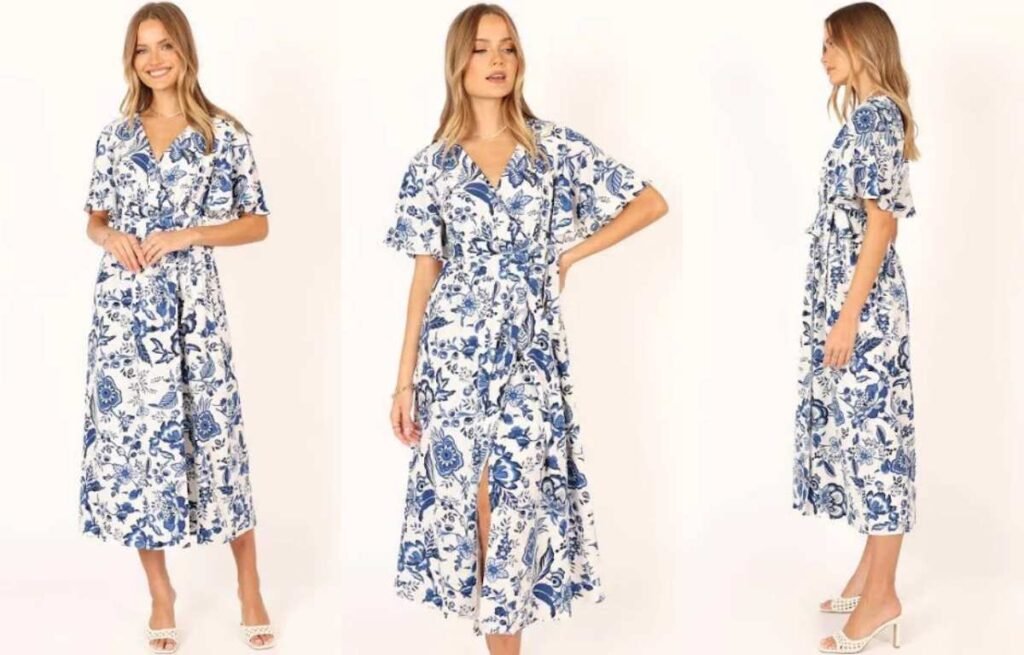
Wrap dresses seem simple, but they’ve stayed stylish for decades across generations.
The wrap dress is defined by its front closure, where one side of the dress wraps across the other and ties at the waist. This creates a natural V-neckline and adjustable fit that flatters almost every body type.
What makes the wrap dress so versatile for different occasions and body types?
This dress works for almost every setting—from work to date nights to vacation.
Its adjustability, waist-defining shape, and flattering neckline make it suitable for all ages and figures. The wrap design enhances curves without clinging, and it can be styled up or down depending on fabric and accessories.
Why the Wrap Dress Is a Design Powerhouse
The wrap dress has lasted for decades not just because it looks good, but because it’s smart design. Here’s why it’s more than just a pretty silhouette:
1. Universally Flattering Shape
The adjustable wrap design cinches the waist and creates a V-neckline, which helps elongate the neck and enhance the bust. For women with fuller hips or curves, the wrap naturally glides over the lower body without clinging. For straighter body types, it adds shape and softness. The result is a balanced, feminine silhouette.
2. Size Flexibility
Because it wraps and ties rather than relying on zippers or rigid cuts, a wrap dress can accommodate minor weight changes or different body proportions. This makes it a favorite for both ready-to-wear collections and custom clothing, and especially appealing in wholesale or fast-moving retail models.
3. Easy to Dress Up or Down
The wrap dress is like a blank canvas. In cotton jersey, it’s casual and comfortable for everyday wear. In silk or satin, it instantly becomes a sleek choice for dinner or events. With a blazer, it works for the office. With heels and jewelry, it’s ready for cocktails. The same cut serves multiple markets.
4. Culturally Adaptable
While most associate the wrap dress with Western fashion, its design is adaptable across global tastes. The tying method can be shifted to one side or centered. Necklines can be adjusted for modesty. Sleeves can be short, long, or puffed. This design is flexible enough to work in various regions and cultural aesthetics.
5. Travel-Friendly and Comfortable
Since most wrap dresses are made of jersey, rayon, or viscose blends, they tend to be wrinkle-resistant and lightweight. That makes them an ideal garment for travel-focused consumers. Plus, the easy tie-on/tie-off function adds to their practicality.
Key Characteristics of a Wrap Dress:
- Closure: Wraps around and ties at the waist
- Neckline: V-shaped, naturally formed
- Fit: Adjustable to body shape
- Silhouette: Feminine, flowy, often A-line
- Styling: Pairs well with belts, jackets, boots or heels
Wrap Dress vs. Similar Styles
| Feature | Wrap Dress | Fit-and-Flare Dress | Shirt Dress |
|---|---|---|---|
| Closure Style | Wrap and tie | Zipper or pull-on | Buttons down front |
| Adjustability | High (self-tie) | Moderate | Low |
| Body Type Suitability | Most body types | Hourglass or slim shapes | Straight or rectangular |
| Form Versatility | Day to night | Mostly casual to semi-formal | Casual to office |
Best Fabrics for Wrap Dresses
Fabric can totally change the tone of a wrap dress. Here are some of the most popular options:
- Jersey/Rayon Blends: Soft, stretchy, ideal for everyday styles
- Silk/Satin: Sleek and drapey, great for formal or evening wear
- Cotton/Linen: Breathable and fresh, perfect for summer
- Chiffon/Georgette: Lightweight and flowy, good for layering or occasion wear
- Knits: Add texture and comfort, suitable for cooler weather
Empire Waist Dress
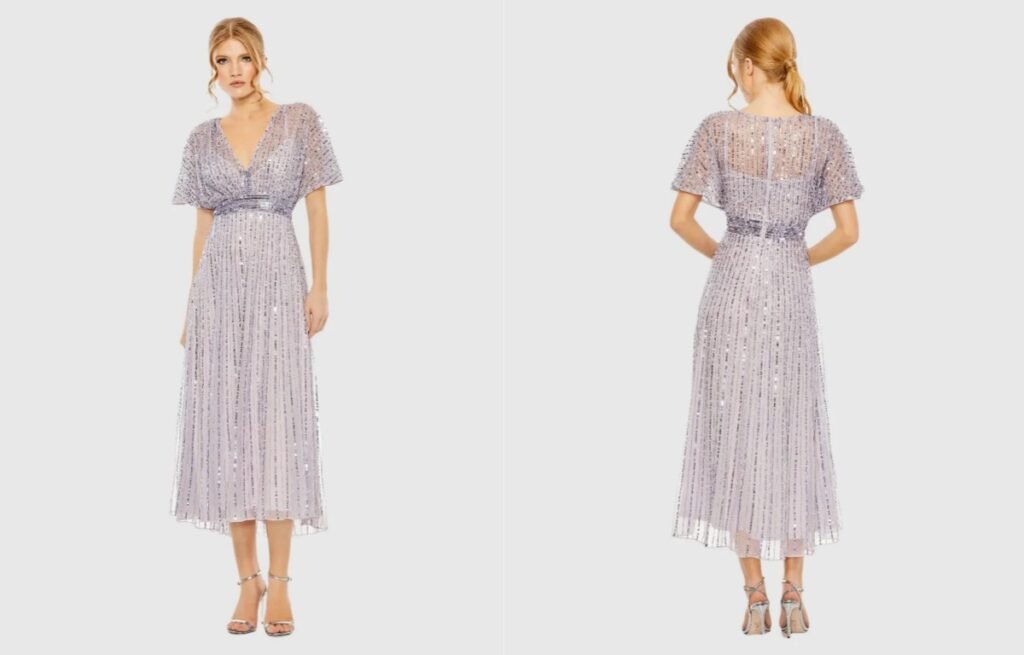
The empire waist dress is often praised for its elegance—but what truly sets it apart?
An empire waist dress features a raised waistline that sits just below the bust, allowing the fabric to fall loosely over the rest of the body. This silhouette has been favored for centuries due to its graceful shape, comfortable fit, and flattering effect on many body types.
How does the empire waist dress flatter different body shapes?
Empire waist dresses are known for their universally flattering shape—but how exactly do they work?
The high waistline elongates the legs and skims over the stomach and hips, making this style ideal for petite, apple, and pear-shaped figures alike. It draws attention upward and creates a soft, flowing silhouette that suits casual and formal settings.
The Design Strategy Behind the Empire Waist
The popularity of the empire waist dress is no accident. Its design speaks to both aesthetic elegance and thoughtful function:
1. Historical Influence and Modern Revival
The empire waist originated in the early 1800s, popularized during the Regency era in Europe. The clean lines, high waist, and flowing fabric were associated with grace and femininity. Today, designers revisit this silhouette in both vintage-inspired and modern contexts.
- Regency Era Look: Lightweight fabrics, puff sleeves, and soft pleats
- Modern Takes: Fitted busts, minimalist lines, and daring fabrics
This blend of history and contemporary design gives the empire waist timeless appeal.
2. Visual Lengthening and Slimming
The raised waist creates a vertical illusion, drawing the eye upward and making the legs appear longer. This is especially useful for:
- Petite women: Adds height visually
- Apple-shaped bodies: Conceals the midsection without clinging
- Pear-shaped bodies: Balances the lower half by emphasizing the bust and neckline
3. Comfort Without Sacrificing Elegance
The empire waist dress avoids tight fits around the waist and hips, making it a top choice for comfort. Whether it’s worn during pregnancy, summer travel, or special occasions, it allows ease of movement while still looking polished.
| Feature | Empire Waist Dress | A-Line Dress | Bodycon Dress |
|---|---|---|---|
| Waistline Position | Just below the bust | Natural waist | Follows body curves |
| Fit Around Midsection | Loose and flowy | Slight flare from waist | Tight and contoured |
| Best For | Petite, curvy, pregnant figures | Most body types | Hourglass, slim shapes |
| Visual Effect | Elongates legs, softens curves | Balanced, flattering | Defines shape, bold look |
4. Versatility Across Occasions
Empire waist dresses can be styled for many different settings:
- Casual wear: Made with cotton or jersey, paired with flats or sandals
- Formal events: Satin or chiffon versions with delicate detailing
- Boho styles: Embroidered or printed fabrics for a free-spirited look
- Maternity: Adjustable empire seams for growing bellies
This flexibility is one reason the silhouette is so widely used in retail and boutique collections.
What are the best fabrics and features for empire waist dresses?
The fabric affects how the dress flows and fits.
Light, drapey fabrics like chiffon, rayon, and soft knits work best. They allow the dress to fall naturally from the bust, creating a clean, graceful silhouette. Stiffer fabrics can add structure but might reduce the flowing effect.
Ideal fabric choices:
- Chiffon: Perfect for evening or formal wear
- Rayon/Viscose: Comfortable and soft, ideal for everyday wear
- Cotton blends: Great for casual or boho styles
- Lace or embroidered mesh: Adds detail and texture for special occasions
Peplum Dress

What makes the peplum dress a timeless favorite in women’s fashion?
The peplum dress never disappears from fashion—it just evolves with the times.
A peplum dress features a short, gathered or pleated strip of fabric attached at the waist, creating a flared, ruffle-like effect. This extra layer adds shape, flatters the waist, and gives the garment a structured, feminine silhouette.
I remember seeing a tailored peplum dress at a tradeshow in Paris—classic black, sharp lines, and it instantly stood out among minimalist designs.
Why does the peplum design work so well on different body types?
Its secret lies in balancing proportions.
The peplum enhances the waistline and adds volume to the hips, creating an hourglass illusion that works for many figures. It emphasizes curves in a structured way without being too revealing.
The Construction and Styling Power of Peplum Dresses
Peplum dresses are more than decorative—they’re a carefully engineered piece of fashion history that blends aesthetics with visual shaping.
1. Visual Structure and Balance
The flared peplum panel is designed to highlight the waist while creating visual balance between the upper and lower body. This makes the silhouette appear more proportioned, especially for straight or rectangle body shapes.
- Hourglass effect: The peplum cinches at the narrowest point of the waist and flares out, mimicking the natural curve of the hips.
- Balancing wider shoulders: For those with broad shoulders, the extra volume at the hips draws attention downward and creates symmetry.
2. Variety in Peplum Placement
Although most peplum dresses place the flounce at the natural waist, some designs adjust the placement for different styling effects:
- High-waisted peplum: Accentuates the upper body and lengthens the legs.
- Low-waisted peplum: Adds more drama and emphasizes the hips.
- Asymmetrical peplum: Introduces visual movement and modernity.
3. Fabric Matters
The volume and drape of the peplum depend heavily on the fabric used. Structured fabrics like scuba, neoprene, or taffeta give sharp, sculpted flares. Softer fabrics like crepe or jersey result in a gentler, flowing ruffle.
| Fabric Type | Effect on Peplum | Best For |
|---|---|---|
| Neoprene / Scuba | Structured, modern flare | Office dresses, statement pieces |
| Crepe / Jersey | Soft, natural drape | Daywear, casual styling |
| Taffeta / Satin | Crisp, elegant structure | Formal or evening dresses |
4. Occasion Versatility
Peplum dresses fit effortlessly into both casual and formal wardrobes.
- Workwear: Pairing a peplum dress with heels offers a confident, polished look.
- Evening wear: A peplum gown with satin fabric elevates the elegance factor.
- Street style: Minimalist peplum designs in knit or cotton make for trendy daywear.
5. Styling Tips for Peplum Dresses
To keep the focus on the peplum detail, accessories should stay minimal. Opt for pointed-toe shoes to elongate the legs and avoid oversized belts that could compete with the waist detail.
- Do: Wear simple heels, sleek jewelry, and fitted outerwear.
- Avoid: Over-accessorizing or wearing loose jackets that hide the waist.
Mermaid Dress
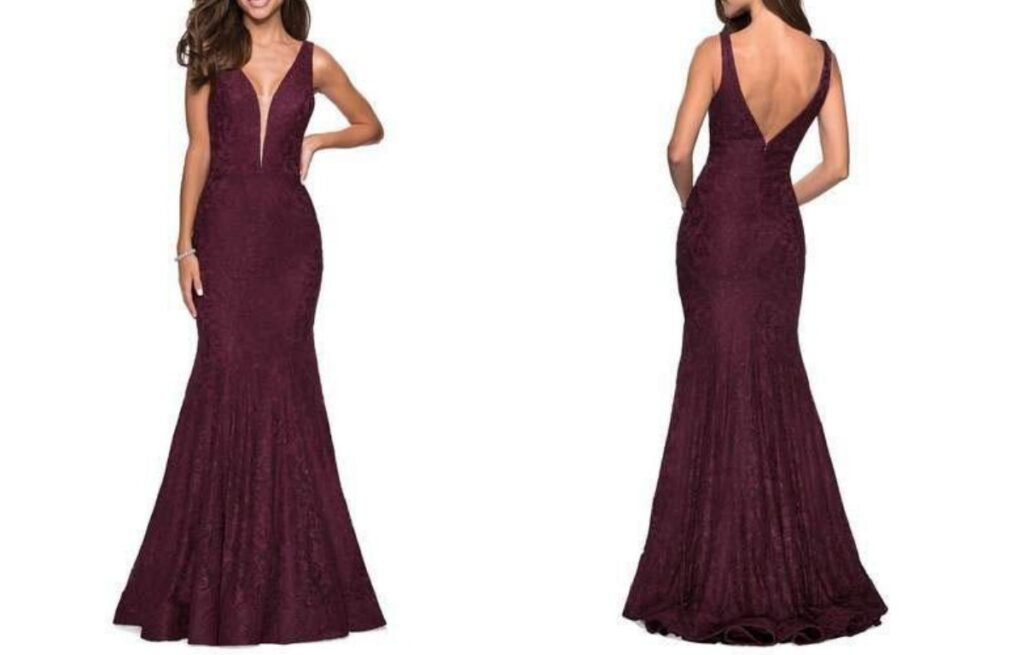
The mermaid dress is dramatic, romantic, and instantly eye-catching.
A mermaid dress is fitted through the bodice, waist, and hips, then flares out at the knees or lower—mimicking the silhouette of a mermaid’s tail. It’s a favorite for formal events, red carpets, and weddings due to its elegant, figure-hugging style.
Why is the mermaid dress so flattering and dramatic?
The mermaid dress creates instant glamour and elegance, perfect for occasions that demand a standout look.
It hugs the body in all the right places and dramatically flares at the hem, making it one of the most structured and bold dress styles in women’s fashion.
The Design Power of the Mermaid Dress
The mermaid dress is more than just a formalwear staple—it’s a masterclass in silhouette control, construction, and visual drama.
Contouring the Body:
The defining feature of the mermaid dress is how it sculpts the torso, waist, and hips. The tailored fit enhances curves while offering a slimming effect through strategic seam placement and fabric tension. This makes it a powerful tool for designers looking to create a bold, hourglass silhouette.
Flaring from the Knee:
The flare typically begins at or just below the knee, which adds dramatic movement when walking. This flare is often created with godets, panels, or pleats that allow the bottom to fan out beautifully. The volume creates balance with the tightly fitted upper portion, adding grace and proportion.
Perfect for Formal Occasions:
The mermaid dress is ideal for weddings, red carpets, and galas. It naturally draws attention and photographs beautifully due to its structured shape. Bridal designers especially favor it for its romantic elegance and figure-enhancing design.
Fabric Considerations:
Mermaid dresses require materials that can hold shape without sacrificing flexibility. Satin, stretch crepe, mikado silk, or structured tulle are common choices. These fabrics provide both smooth surface tension and enough body for the flared hem to hold its form.
Body Type Suitability:
While the mermaid style looks stunning, it’s most flattering on hourglass, pear, and slender figures. It emphasizes the waist and hips, so it works best on wearers who are confident highlighting their curves. For apple or rectangular shapes, slight modifications (like raised flare lines or added support panels) can make the style more inclusive.
Key Elements of the Mermaid Dress:
- Fit: Tight from bust through thighs
- Flare: Begins at or below the knee
- Length: Usually floor-length or with a train
- Neckline Options: Strapless, sweetheart, off-shoulder, halter
- Closure: Invisible zipper, corset lace-up, or back buttons
Mermaid Dress vs. Other Dress Silhouettes
| Feature | Mermaid Dress | Trumpet Dress | A-line Dress |
|---|---|---|---|
| Fit | Tight to knees | Fitted to mid-thigh | Fitted bodice, flared skirt |
| Flare start point | Knee or below | Mid-thigh | Above the hips |
| Visual impact | Dramatic, body-hugging | Elegant, slightly less tight | Soft and universally flattering |
| Ideal use | Weddings, formal galas | Cocktail parties, weddings | Casual to formal wear |
Styling Tips for Mermaid Dresses
When wearing a mermaid dress, let the silhouette be the statement. Avoid oversized accessories or bulky layers that interrupt the clean lines. Opt for minimal jewelry, elegant heels, and hairstyles that balance the bold lower silhouette—like sleek buns or soft waves.
Ball Gown
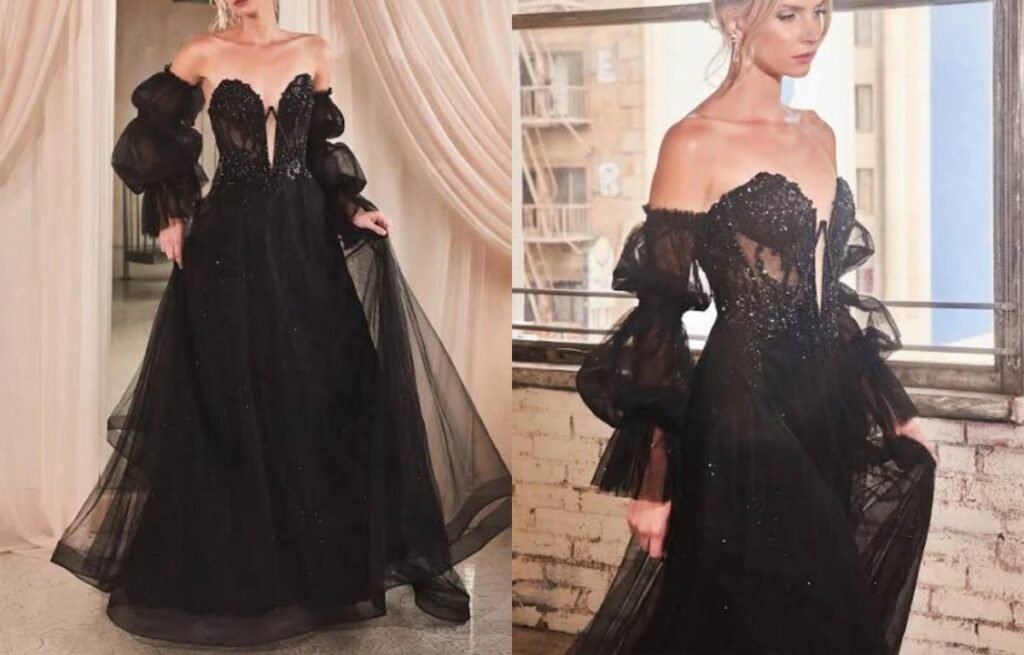
When people imagine a fairytale dress, the ball gown is usually what comes to mind.
The ball gown features a fitted bodice and a dramatically full skirt, often floor-length, designed to create a stunning, regal silhouette. It’s traditionally worn for formal events like galas, red carpet appearances, or weddings.
What makes the ball gown one of the most iconic dress styles?
The ball gown isn’t just a silhouette—it’s a statement of drama, luxury, and tradition.
Its full skirt and structured bodice create a powerful visual balance, drawing attention to the waist while emphasizing femininity. This style continues to be a favorite for designers who want to make a bold, elegant impact.
Structure, Function, and Cultural Influence
The ball gown has remained relevant across centuries for several key reasons. Its history, design structure, and adaptability to modern aesthetics give it a lasting presence in the fashion world.
Historical Prestige:
Originating in European royal courts in the 18th and 19th centuries, the ball gown was a symbol of status and grace. Worn during balls and formal gatherings, it was used to reflect a woman’s place in society. Though today’s versions are modernized, the ball gown still carries that aura of sophistication.
Design Structure and Construction:
A traditional ball gown includes:
- Fitted Bodice: Often corset-style or structured with boning, designed to shape the upper body.
- Defined Waistline: Accentuated either at the natural waist or slightly above (empire waist for some variations).
- Full Skirt: Created using layers of tulle, crinoline, or hoop skirts to maintain volume and movement.
- Neckline Variety: From sweetheart and off-the-shoulder to halter or high-neck, allowing designers to adjust mood and coverage. The skirt’s volume is supported by multiple underlayers or built-in petticoats, giving it that dramatic sweep across the floor.
Flattering All Body Types:
One reason the ball gown remains universally beloved is its flattering silhouette. By emphasizing the waist and disguising the lower body, it’s particularly suitable for pear-shaped, hourglass, or rectangle figures.
Occasion-Specific Impact:
This dress is best reserved for black-tie events, formal weddings, prom nights, or red carpet galas. It’s not an everyday piece—but when it’s time to make a statement, nothing compares.
Modern Interpretations:
Today’s ball gowns range from traditional to fashion-forward:
- Minimalist Designs: Clean lines, matte satin, and no embellishment—perfect for modern brides.
- Couture Embellishment: Heavy beading, embroidery, and dramatic trains for red-carpet impact.
- Asymmetry & Layer Play: Layered tulle or organza used in sculptural ways to create dimension and movement.
Ball Gown vs. Other Formal Dress Types
| Feature | Ball Gown | A-line Dress | Mermaid Dress |
|---|---|---|---|
| Skirt Volume | Very full | Moderate flare | Fitted throughout |
| Bodice Fit | Structured, corseted | Fitted but softer | Very body-hugging |
| Ideal For | Formal, high-impact events | Semi-formal to formal | Glamorous, body-conscious |
| Comfort Level | Less practical, very grand | Easier to move in | Restrictive, stylish |
Best Fabrics for Ball Gowns
Ball gowns depend heavily on fabric selection to achieve volume and luxury. Here are common choices:
- Tulle: Lightweight and voluminous, ideal for layering.
- Organza: Sheer but holds shape well, often used in overlays.
- Satin & Mikado: Luxurious and structured, perfect for formal elegance.
- Chiffon: Sometimes used in layered soft versions of the skirt.
- Velvet: Used in winter ball gowns for a rich, heavy look.
Styling Tips for Wearing a Ball Gown
Because of its dramatic structure, it’s best to:
- Keep accessories elegant and minimal.
- Wear hair up or styled away from the neckline to let the bodice shine.
- Choose heels that offer support—ball gowns are heavy and long.
- Opt for fitted undergarments or shapewear to enhance the clean lines of the bodice.
Mini Dress
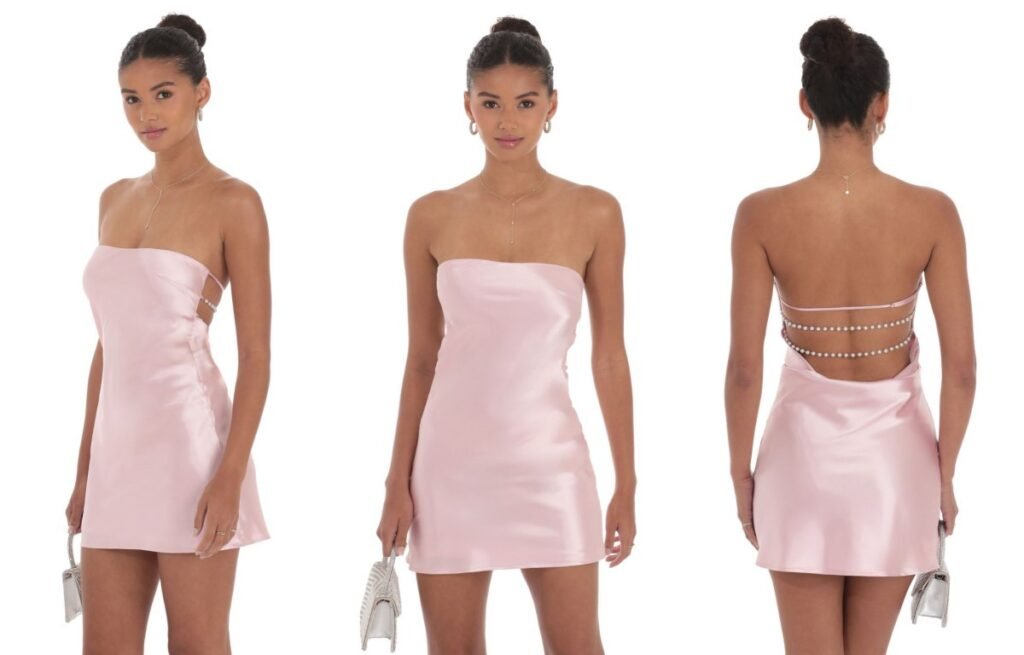
The mini dress has stayed relevant for decades—and it’s not going away anytime soon.
A mini dress is defined by its hemline, typically falling mid-thigh or above, offering a bold, leg-revealing silhouette. It’s a symbol of confidence, youth, and freedom, with endless styling possibilities for both casual and formal settings.
Why has the mini dress remained iconic across decades?
The mini dress is more than a trend; it’s a cultural and fashion statement.
Its consistent appeal lies in its ability to adapt across decades—reshaped by trends, but always keeping its core essence: short, stylish, and attention-grabbing.
Mini Dress as a Cultural Symbol and Versatile Staple
Historical Roots & Cultural Impact:
The mini dress first gained popularity in the 1960s, largely credited to designer Mary Quant and the rise of youth culture. It was revolutionary—challenging norms and becoming a visual symbol of female empowerment and rebellion. From 1960s mods to 2000s pop icons, the mini dress has continuously evolved with each generation, never losing relevance.
Modern Styling Flexibility:
One reason the mini dress endures is its adaptability. Today, mini dresses come in various silhouettes—bodycon, A-line, wrap, and shift—making them suitable for many occasions. A structured blazer-style mini dress might work for evening events, while a cotton A-line mini fits casual daywear. Its length allows for statement footwear and layered styling, making it a favorite among fashion-forward women.
Flattering Different Body Types:
Contrary to common belief, mini dresses can flatter many body shapes. A high-waisted, A-line mini dress elongates the legs and balances proportions. Stretch bodycon versions highlight curves. The key is choosing the right neckline, fabric, and structure.
Youthful and Empowering Vibe:
Wearing a mini dress sends a message—it’s bold, self-assured, and energetic. It appeals to Gen Z and Millennials especially, who value individuality and expressive dressing. Even older demographics are embracing modern versions, often pairing them with oversized jackets or boots for age-appropriate styling.
Fashion Retailer Favorite:
From high-street to luxury fashion, mini dresses are a core product in most collections. They perform well in online retail due to their eye-catching appearance in visuals and low production cost. For boutiques and brands, they offer a high return on style with relatively minimal fabric use.
Common Mini Dress Silhouettes:
- Bodycon – Tight-fitting, stretch material, night-out favorite
- A-line – Flares gently from the waist, flattering for many shapes
- Wrap – Adjustable fit, elegant and feminine
- Blazer Dress – Sharp tailoring, perfect for chic events
- Smocked or Shirred Mini – Trendy, youthful, comfortable
Mini Dress vs Other Dress Lengths:
| Feature | Mini Dress | Midi Dress | Maxi Dress |
|---|---|---|---|
| Hemline | Above the knee | Mid-calf | Ankle or floor length |
| Style Impact | Bold, youthful | Balanced, modest | Dramatic, elegant |
| Best For | Parties, summer, nightlife | Work, casual, semi-formal | Weddings, beachwear, evening |
| Styling Options | Boots, sneakers, layered | Heels, flats, layers | Sandals, statement belts |
What are the best fabrics for mini dresses?
Fabric choice depends on the purpose and style of the mini dress.
For structured minis, opt for poplin, ponte, or denim. For soft, flowy styles, use rayon, chiffon, or modal. For bodycon types, ribbed knits and spandex blends offer a snug fit.
When I develop mini dress styles, I always start by aligning fabric with function—if it’s meant for daywear, breathability matters. For partywear, stretch and structure take priority.
Knee-length Dress

The knee-length dress is a classic silhouette that balances elegance and practicality. Its length flatters most body types, works for various occasions, and adapts easily to trends and fabrics.
I’ve styled countless samples of this type for brands looking to hit that sweet spot between formal and casual—it always works.
What makes knee-length dresses so versatile?
It’s all about that “just right” length—not too long, not too short.
Knee-length dresses hit right at or slightly below the knee, offering both mobility and modesty. They’re ideal for everything from workwear to date nights, and they transition easily from day to evening.
Why Knee-Length Dresses Keep Dominating Fashion
Knee-length dresses aren’t just popular—they’re strategic. Here’s a breakdown of why this length works so well:
Body-Flattering Balance
The knee-length cut visually divides the body in a way that elongates the torso and legs. It draws attention to the narrowest part of the lower body—right around the knees—creating a slimming, balanced silhouette for most women.
Cross-Occasion Wearability
Whether it’s a tailored sheath dress for the office, a wrap dress for brunch, or a flared skater dress for a night out—this length fits them all. Unlike mini or maxi dresses that often feel context-specific, knee-length dresses are universally appropriate.
Global Appeal
In different cultures and markets, knee-length dresses are often considered the most acceptable for both modesty and style. In export markets like North America, Western Europe, and Australia—where dress codes vary—this silhouette can serve multiple retail segments.
Adaptable to Different Styles
Designers love this length because it acts like a neutral base—it works with flared, A-line, pencil, pleated, or shift shapes. Pair it with different sleeve types, neckline cuts, or prints, and it transforms completely.
Age and Demographic Flexibility
From Gen Z to mature shoppers, women of all ages can wear knee-length styles without feeling out of place. Younger buyers may gravitate toward trendy cuts or sporty styles, while older audiences prefer structure and elegance—yet both find the same length appealing.
Common Knee-Length Dress Types:
| Style Name | Description | Ideal For |
|---|---|---|
| Sheath Dress | Slim-fit, clean silhouette | Office, formal wear |
| Wrap Dress | Tied at the waist with V-neckline | Everyday elegance |
| Skater Dress | Fitted bodice, flared skirt | Casual, date night |
| Shirt Dress | Button-down, often belted at waist | Business casual, layering |
| A-line Dress | Flares gently from waist to hem | Universally flattering |
What fabrics and prints work best with knee-length dresses?
The fabric changes the mood of the dress entirely.
Light cottons and linens feel breezy and casual, while structured ponte or crepe make it work-ready. For eveningwear, silks or satins offer elevated elegance.
Depending on season and trend, floral prints, solid basics, plaids, or abstract patterns all work well on this length. It’s a flexible base.
Midi Dress
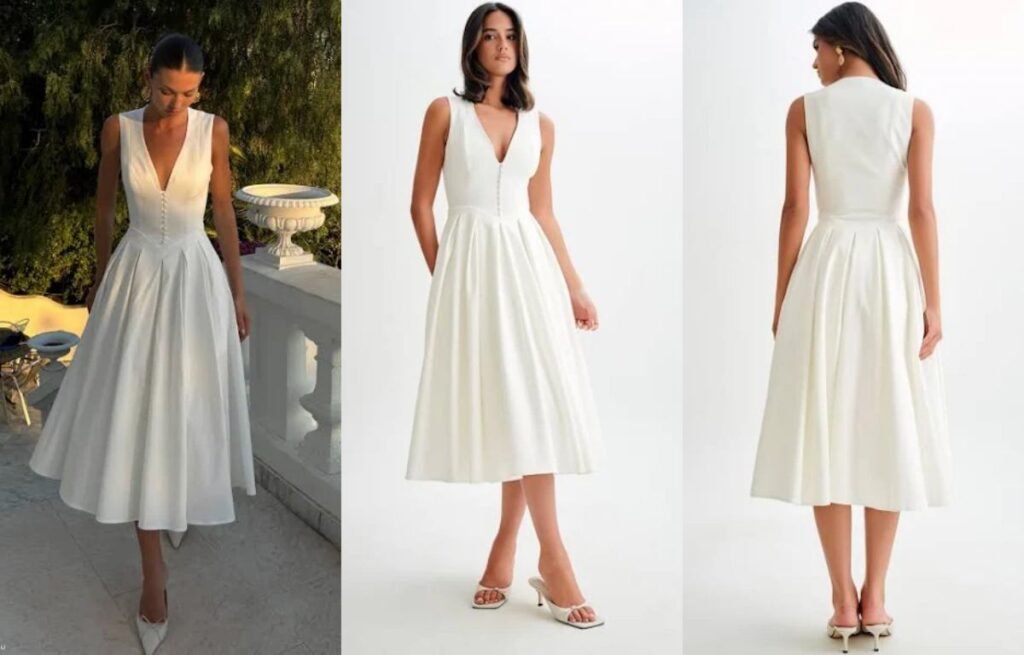
The midi dress hits a sweet spot in style and function—neither too long nor too short.
A midi dress typically falls between the knee and ankle, offering a balance of elegance and everyday wearability. It’s one of the most requested silhouettes in modern womenswear, especially for brands targeting Gen Z and Millennial consumers.
We receive constant inquiries from boutique brands requesting updated midi styles—whether it’s bodycon, flowy, or with a slit.
Why is the midi dress essential for fashion brands—and manufacturers?
From a production standpoint, midi dresses strike the ideal balance between material use, size coverage, and trend longevity.
They’re versatile across seasons and markets, cost-efficient to produce, and easy to customize with neckline, sleeve, or fabric variations. That’s why we often prioritize them in both ready-to-ship and made-to-order programs.
Manufacturing Insights Behind the Midi Dress
To fully understand why midi dresses are such a go-to style for manufacturers like us, we need to break down both the design flexibility and supply chain efficiency they offer.
1. Optimized Fabric Usage
Unlike maxis (which require more fabric and longer production times) or minis (which can feel too niche for certain markets), midi dresses offer an ideal fabric-to-price ratio.
- Average fabric consumption: 1.8–2.2 meters (varies by silhouette and size)
- Less cutting waste: Cleaner marker layout, especially with viscose, rayon, cotton blends
This helps us optimize fabric yield and reduce production waste—a key point for clients focused on both cost and sustainability.
2. Multi-Seasonal Demand
Midi dresses are easy to adapt for both warm and cool seasons. Simply adjust:
- Sleeves (e.g., tank top, puff sleeve, long sleeve)
- Fabric weight (e.g., chiffon for spring, rib knit for fall)
- Details (e.g., back slit, drawstring waist, mock neck)
For us as a manufacturer, this means we can repurpose a base pattern into multiple styles throughout the year—saving pattern-making costs and time.
3. Strong Fit Range for Global Markets
The midi length works well across regions—from Australia to North America to Europe—because it flatters a wide range of body types and fits modesty standards.
This global acceptance reduces the risk of unsold inventory due to cultural or fit mismatches.
4. Easy Customization for Brand Identity
Many of our B2B clients choose midi dresses as their base silhouette and customize:
- Necklines: sweetheart, square, halter, V-neck
- Sleeves: flutter, off-shoulder, balloon, long sleeve
- Add-ons: lace panels, ruching, slits, tiered hems
We often recommend this approach for emerging brands to create signature looks without investing in totally new patterns.
5. Production Efficiency in MOQ and Lead Time
Because midi dresses are high in demand and easy to scale, we often pre-stock core fabrics and trimmings in neutral colors.
This allows us to offer:
- Lower MOQs: often from 80–100 pcs per style
- Faster lead times: sometimes under 20–25 days for repeat orders
- Easier QC process: since the silhouette is familiar to sewing teams
Recommended Fabrics for Midi Dress Manufacturing
| Fabric Type | Key Benefits | Ideal For |
|---|---|---|
| Rayon | Soft drape, breathable | Summer casual styles |
| Cotton Blends | Comfortable, natural texture | Everyday wear, boho looks |
| Viscose | Smooth, flowy, slightly dressy | Resort and brunch styles |
| Rib Knit | Stretchy, body-hugging fit | Bodycon or fall-winter collections |
| Poly Satin | Shiny, elegant | Occasion wear and party dresses |
Styling Opportunities for Midi Dresses
The midi dress transitions well between day and night, city and vacation. For wholesale buyers, this flexibility means:
- Easy to create capsule collections
- High return on investment per design
- Faster customer sell-through rates
It’s also a favorite among end consumers for styling with sneakers, heels, or boots—making it a key wardrobe staple.
Tea-length Dress
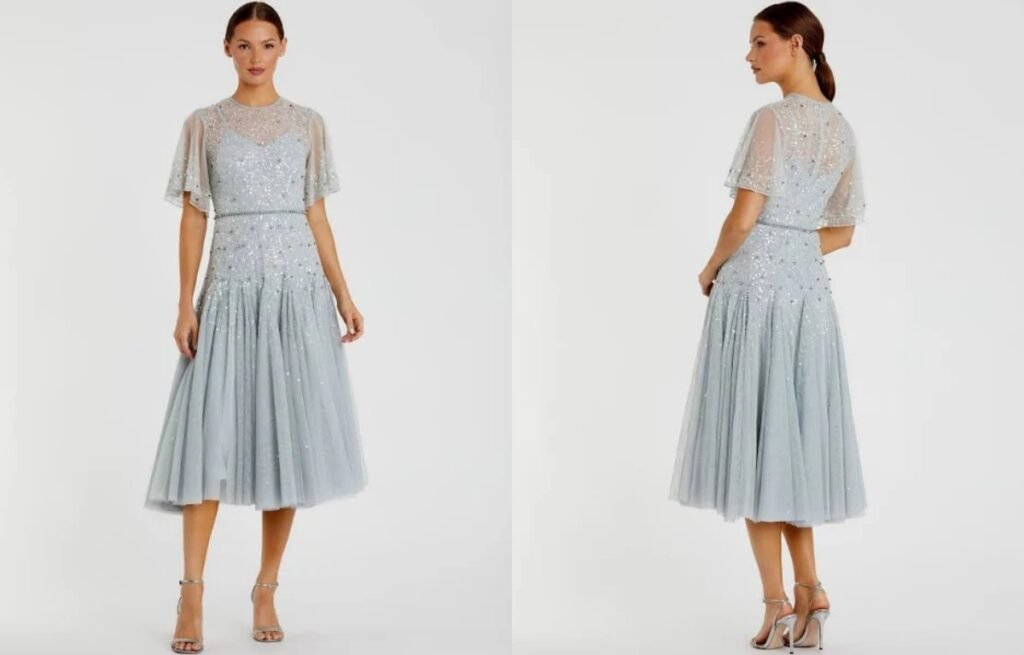
The Tea-Length Dress has a classic charm, sitting between a midi and full-length hemline, making it both elegant and practical.
Falling just below the knee or mid-calf, tea-length dresses are known for their vintage elegance and flattering silhouette, suitable for formal events, weddings, and sophisticated daytime occasions.
Why is the tea-length dress a staple in women’s fashion?
Tea-length dresses hold a unique spot in fashion history and remain relevant for modern wardrobes.
They offer the grace of a long dress with the comfort of a shorter hemline, making them ideal for semi-formal and special occasions where balance is key.
A Closer Look at Tea-Length Dress Appeal
The tea-length dress has evolved across decades, from vintage tea parties to contemporary runways. Here’s why it continues to thrive:
Historical Roots with Lasting Influence:
Originating in the 1920s and becoming iconic in the 1950s, tea-length dresses were originally worn for afternoon teas and social gatherings. They reflected elegance without being too formal. Designers like Christian Dior further elevated the silhouette in the post-war era with fuller skirts and cinched waists, adding a timeless, feminine charm that’s still embraced today.
Flattering Proportions:
Tea-length dresses flatter most body types. The mid-calf hem draws the eye to the narrowest part of the leg, elongating the figure without revealing too much. Paired with heels, it enhances posture and balance. For petite women, a slightly higher calf-length helps avoid a shortened look, while taller frames benefit from full-volume skirts that maintain proportion.
Perfect for Transitional Occasions:
These dresses are ideal for events that fall between casual and formal—garden parties, bridal showers, weddings, or creative work settings. They’re polished enough to be sophisticated, yet breathable and comfortable for long hours.
Styling Flexibility:
Tea-length dresses adapt well across fashion genres. From vintage-inspired polka dots and florals to sleek modern cuts with bold colors or minimal lines, the style suits various aesthetics. Add a belt for definition, a blazer for formality, or sneakers for a casual-chic twist.
Seasonal Adaptability:
They work across seasons with ease:
- Spring/Summer: Light cotton, chiffon, or lace versions in pastels or floral prints
- Fall/Winter: Heavier fabrics like velvet, wool blends, or structured knits paired with boots and layers
Tea-Length vs. Other Dress Hemlines
| Dress Type | Hemline Position | Best Use Case | Style Impression |
|---|---|---|---|
| Mini Dress | Above the knee | Casual, youthful events | Fun, playful |
| Midi Dress | Mid-calf (can overlap) | Versatile day-to-night | Elegant, modern |
| Tea-Length Dress | Below knee to mid-calf | Semi-formal, elegant affairs | Timeless, romantic |
| Maxi Dress | Ankle or floor-length | Formal, relaxed, boho events | Flowing, graceful |
Best Fabrics and Cuts for Tea-Length Dresses
Fabric and silhouette choices define the overall feel of the tea-length dress:
- Classic Vintage Look: Stiff cottons, tulle underskirts, A-line or fit-and-flare cuts
- Romantic/Formal Feel: Chiffon, satin, or lace, often with soft pleating or empire waistlines
- Modern/Minimalist Edge: Clean lines in crepe, silk, or ponte knit with square or asymmetrical necklines
The right cut also matters:
- Fit-and-flare: Universally flattering
- Wrap styles: Ideal for adjustable comfort
- Sleeveless or off-shoulder: Keeps it airy for warm seasons
- Long sleeves and high necklines: Create a more modest, classic profile
Styling Tips for Tea-Length Dresses
- For a vintage vibe, pair with peep-toe heels, gloves, or a headband.
- For a modern twist, layer with a cropped leather jacket or sneakers.
- Use a belt to define the waist or add a statement clutch for bold contrast.
Maxi Dress
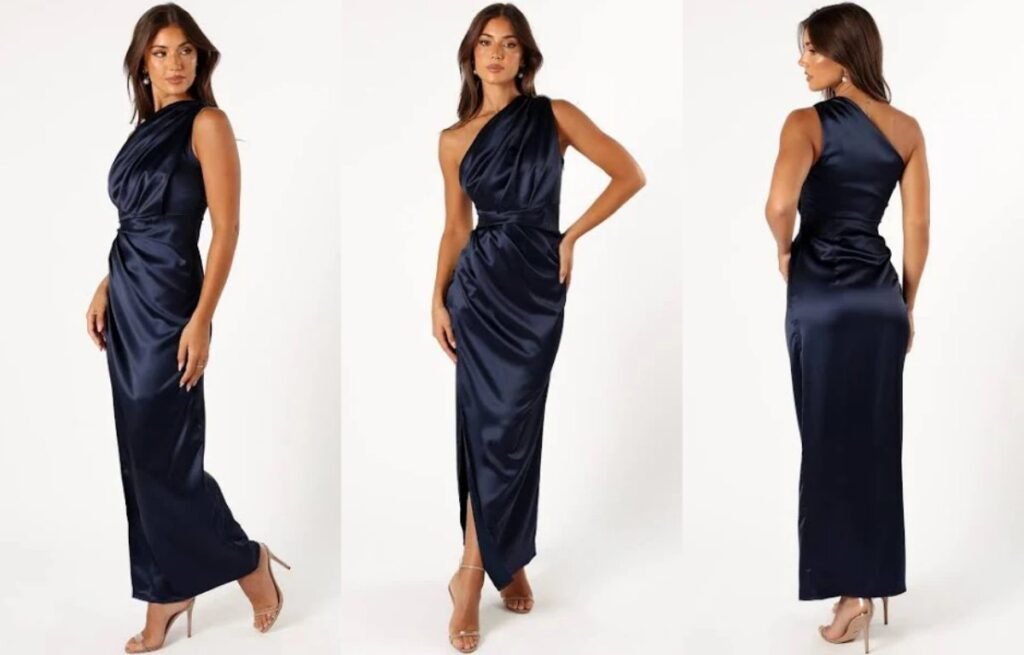
Maxi dresses have never gone out of style—they simply evolve with each season.
A maxi dress is a floor-length or ankle-grazing dress that offers a full-coverage yet effortlessly feminine look. Known for its comfort and versatility, the maxi dress can shift from casual beachwear to elegant eveningwear depending on the cut, fabric, and styling.
What makes a maxi dress so versatile across seasons and occasions?
The charm of the maxi dress lies in its flexibility.
Maxi dresses work in every season and setting—from relaxed daywear to formal occasions—thanks to endless design variations in silhouette, fabric, and styling details.
Understanding the Maxi Dress’s Enduring Popularity
Maxi dresses continue to be a staple in both personal wardrobes and brand collections. Here’s why this silhouette remains relevant year after year:
1. Adaptable Across Styles
The maxi dress isn’t just one look—it’s a category of endless substyles. From bohemian and romantic to minimalist and structured, the maxi dress can take on any personality.
- Boho Style: Often features ruffles, floral prints, and relaxed fits.
- Evening/Formal Style: Uses luxe fabrics like silk, satin, or velvet with structured tailoring.
- Casual Style: Think cotton or jersey knits with tank or t-shirt tops.
2. Flattering for All Body Types
The elongated shape of a maxi dress creates a vertical line that visually elongates the body. When designed thoughtfully, it flatters many body types:
- A-line or empire waist maxis suit pear-shaped bodies.
- Fitted waist with flowing skirt suits hourglass figures.
- Column or straight styles are great for tall and lean body types.
Designers often incorporate subtle tailoring tricks—like cinched waists, side slits, or wrap fronts—to enhance shape without compromising comfort.
3. Seasonal Versatility
The maxi dress easily transitions across seasons:
| Season | Fabric Suggestions | Styling Elements |
|---|---|---|
| Spring | Lightweight chiffon, rayon | Floral prints, pastel shades |
| Summer | Cotton, linen, jersey | Spaghetti straps, open back |
| Fall | Knitted blends, heavier rayon | Long sleeves, earthy tones |
| Winter | Wool blends, velvet | Turtleneck cuts, layering-friendly |
Layering is another key. A sleeveless maxi can be worn over a turtleneck in fall or paired with a cropped jacket in spring, extending its use across seasons.
4. Cultural and Global Relevance
The maxi dress has global appeal. From kaftan-style maxis in the Middle East to the romantic, tiered versions in Europe, the silhouette is deeply embedded in many fashion cultures. That global versatility also makes it a strong B2B product for markets like Australia, North America, and the UK—especially when offered in custom prints or fabrics.
5. High Styling Potential for Brands
For fashion brands and buyers, maxi dresses offer strong upselling potential through customization. Features like:
- Adjustable waist ties
- Layered ruffle hems
- Statement sleeves
- Convertible straps
Best Occasions to Wear a Maxi Dress?
From casual to formal, the maxi dress fits almost everywhere.
Maxi dresses are ideal for weddings, vacations, beach outings, date nights, or simply lounging at home—depending on the material and cut.
When I develop collections for boutique clients, maxi dresses often become the hero products. They’re easy to style, require minimal accessories, and make customers feel instantly “put together.”
Styling suggestions by occasion:
- Beach day: Linen or cotton maxi, flat sandals, oversized hat
- Dinner date: Silk maxi with slit, heels, layered necklace
- Office-friendly: Wrap-style maxi in solid tone, blazer, low heels
- Travel look: Stretchy jersey maxi, sneakers, crossbody bag
V-Neck Dress

The V-neck dress is simple in shape but powerful in effect.
This dress features a neckline that dips down in a “V” shape, flattering the collarbone and elongating the neck. It suits a wide range of body types and works across casual, professional, and evening styles.
What makes the V-neck silhouette so universally flattering?
The cut may be minimal, but its visual impact is powerful.
The V-shape draws the eye vertically, creating a lengthening effect for the neck and upper body. It adds subtle definition to the bust and can balance proportions, making it one of the most adaptable neckline choices in women’s fashion.
Fit, Body Types, and Styling Versatility
Let’s take a closer look at why the V-neck dress consistently ranks as a top choice in design and personal styling:
Body-Flattering Geometry:
The V-neckline creates a strong vertical line. This is key for elongating the torso, particularly beneficial for women with shorter necks or rounder face shapes. It also brings attention to the center of the body, drawing the eye inward and creating a slimming illusion.
Bust Balance and Proportion:
For women with larger busts, a modest V-neck helps open up the chest area without adding bulk. It creates space and lightness around the upper body. For smaller-busted women, a deeper V can create the illusion of a fuller shape, especially when paired with details like ruching, wraps, or built-in cups.
Shoulder and Waist Definition:
V-neck dresses help define the shoulders while subtly guiding the eye down to the waist, emphasizing an hourglass figure. This makes them effective for balancing broader shoulders or highlighting a narrow waist.
Styling for Different Occasions:
One of the key strengths of a V-neck dress is its adaptability.
- For the office, opt for a structured sheath V-neck with a modest depth and sleeves.
- For evening wear, a deep V with luxurious fabrics like silk or velvet adds elegance.
- For casual wear, jersey V-necks or cotton wrap dresses bring relaxed charm.
Layering and Accessories:
V-necklines are friendly to layering. You can pair them with cardigans, blazers, or scarves without bulk at the neckline. They’re also perfect for showcasing necklaces, from delicate pendants to statement pieces.
V-Neck Dress vs. Other Neckline Styles
| Feature | V-Neck Dress | Crew Neck Dress | Square Neck Dress |
|---|---|---|---|
| Neckline Effect | Elongates the neck | Emphasizes upper chest | Adds structure to bust |
| Best for | Most body shapes | Narrow shoulders | Broad shoulders, small bust |
| Style Versatility | Casual to formal | Mostly casual/formal | Romantic, vintage |
Best Fabrics and Dress Styles for V-Neck Designs
The V-neck design works with nearly any fabric, depending on the occasion:
- Cotton and Jersey: For casual V-neck T-shirt dresses and everyday wear.
- Silk and Satin: Ideal for deep V cocktail and evening dresses.
- Knits and Ribbed Fabrics: For fitted styles that hug the body.
- Linen and Poplin: Perfect for summer wrap V-neck styles.
Popular dress silhouettes with V-necklines include:
- Wrap Dresses
- Sheath Dresses
- Fit-and-Flare
- Empire Waist
- Slip Dresses
Sweetheart Neckline Dress
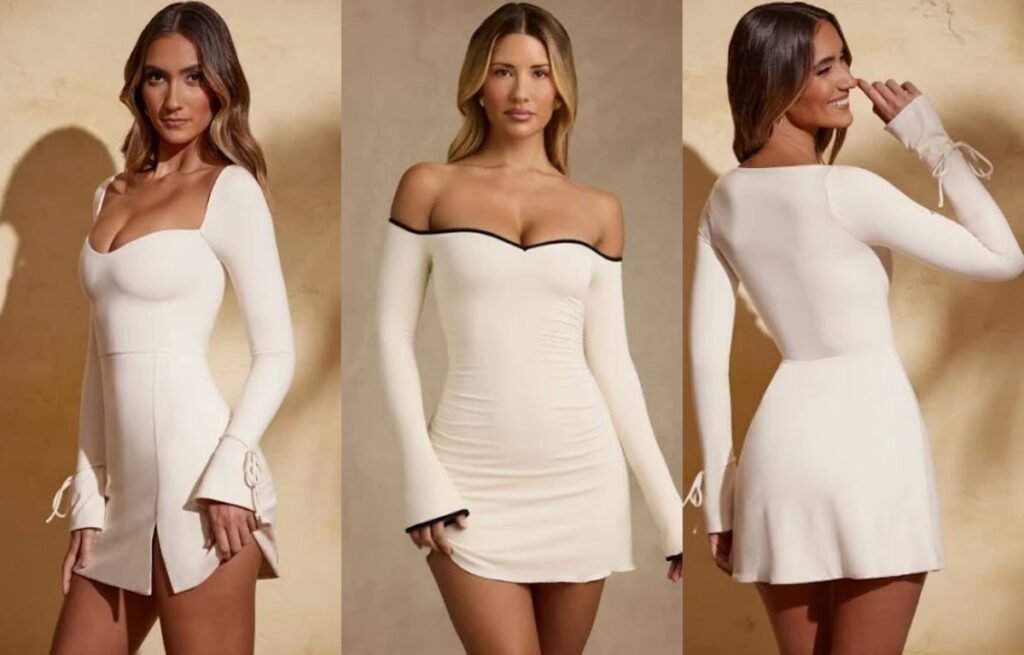
The sweetheart neckline dress is both romantic and classic—it never really goes out of style.
This dress features a neckline shaped like the top of a heart, accentuating the décolletage and giving a feminine, elegant feel. It’s commonly seen in evening gowns, bridal wear, and formal dresses for its universally flattering silhouette.
Why does the sweetheart neckline suit so many body types?
The shape is flattering because it follows the body’s natural lines.
The curved dip in the center of a sweetheart neckline visually lengthens the neck and frames the collarbone, creating an hourglass illusion even on straighter figures.
Designers often choose this neckline when they want to highlight the upper body without revealing too much.
The Design, Fit, and Versatility of the Sweetheart Neckline Dress
The sweetheart neckline might seem simple, but its impact on fit and style is significant. It combines function and beauty in ways that go beyond surface-level aesthetics.
1. Enhancing the Bust Line
The most well-known feature of the sweetheart neckline is how it enhances the bust. The curved top edge draws the eye upward and inward, adding volume to the chest area without the need for additional padding. This makes it particularly flattering for smaller-busted women looking to create shape.
However, for fuller-busted women, the sweetheart neckline offers structure and support when designed with boning, underwire, or a fitted bodice. That’s why it’s often used in bridalwear or corseted dresses—it visually enhances while physically supporting.
2. Creating Balance in Silhouettes
The neckline’s rounded shape can balance broader hips by drawing attention upward. This makes it ideal for pear-shaped bodies, where visual weight distribution is key to achieving a harmonious silhouette.
It also softens angular features, which helps women with square or rectangular face shapes. The neckline’s gentle curve offsets sharp lines and brings femininity to structured styles.
3. Neckline Pairing and Styling Options
Sweetheart necklines are extremely versatile and can be styled in several ways:
- Strapless: Clean and elegant, often used in formal and bridal designs.
- With straps: Adds security and offers a slightly more casual vibe.
- With sleeves: Cap or puff sleeves give it a romantic, vintage look.
- Lace or mesh overlay: Adds texture and modesty while keeping the heart shape visible.
4. Emotional Appeal and Brand Identity
There’s a psychological element to this neckline. The heart shape naturally evokes romance and femininity. That emotional connection makes it perfect for wedding dresses, Valentine’s campaigns, or any product that aims to communicate softness, grace, or classic beauty.
For fashion brands targeting young women or bridal markets, using the sweetheart neckline can position a collection as timeless, emotional, and flattering—key values in brand storytelling.
5. Fabric Compatibility
Sweetheart necklines work well with structured fabrics that hold shape—like satin, taffeta, or duchess silk. But it can also soften with flowing fabrics like chiffon or georgette if the goal is to create a dreamy, romantic effect.
Quick Comparison:
| Feature | Sweetheart Neckline | V-Neck | Square Neckline |
|---|---|---|---|
| Bust Enhancement | High | Moderate | Low |
| Romantic Aesthetic | Very High | Moderate | Neutral |
| Shoulder Emphasis | Depends on strap style | High | Very High |
| Common Occasions | Weddings, galas, formalwear | Casual to formal | Vintage, minimalist styles |
Square Neck Dress
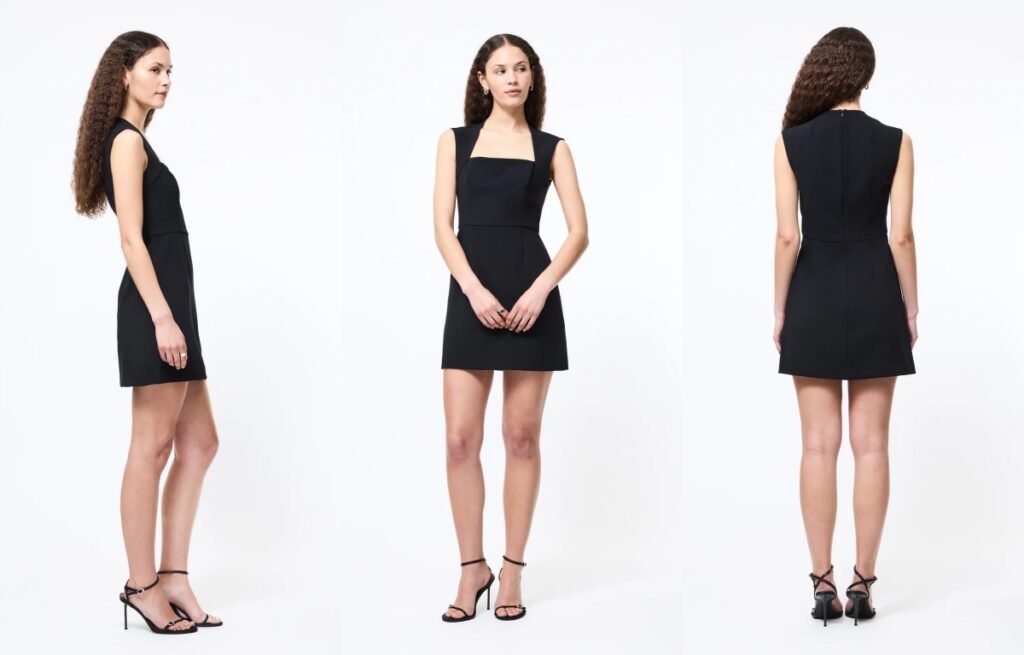
The Square Neck Dress stands out for its clean lines and flattering neckline, making it a timeless favorite in women’s fashion.
This dress style features a neckline with sharp, 90-degree angles that frame the collarbones and elongate the neck, offering a balanced and elegant silhouette. It’s a popular choice for both casual and formal wear due to its versatility and figure-enhancing shape.
Why is the Square Neck Dress so Flattering and Popular?
Square necklines naturally draw attention to the upper body and balance the shoulders, making them universally flattering.
This dress style enhances posture, sharpens the neckline, and works well with most body types, especially those seeking structure or symmetry in their look.
The Design Strengths Behind the Square Neck Dress
The square neck dress isn’t just about a vintage look—it’s about precision, balance, and modern femininity. Here’s what makes it a powerful staple in women’s fashion:
Strong Geometric Lines:
The square neckline provides a clean, architectural shape that brings visual stability to the upper torso. Unlike curved or plunging necklines, the straight edges highlight the collarbones and create a sharp, confident frame around the face and shoulders.
Body Balancing Effect:
For women with narrow shoulders or pear-shaped bodies, the horizontal line of the square neck widens the upper body visually, creating a more proportionate look. On the other hand, for those with broader shoulders, the shape defines without exaggerating width.
Who benefits most from this shape?
| Body Type | Square Neck Effect |
|---|---|
| Pear Shape | Balances wider hips by widening shoulder line |
| Inverted Triangle | Defines neckline without adding volume |
| Hourglass | Accentuates balanced proportions |
| Rectangle | Adds structure and subtle curves |
Perfect for Layering and Accessories:
The straight neckline pairs well with bold or delicate jewelry. It’s also ideal for layering under structured jackets or cardigans without clashing with other design elements. The defined corners make it a strong base for styling.
Versatility Across Styles:
Whether used in a minimal slip dress, a puff-sleeve romantic silhouette, or a corset-style bodice, the square neck adapts well across genres. Designers frequently use it in both classic and trend-forward collections for its ability to look both vintage and modern.
Historical and Contemporary Relevance:
Originating from Renaissance and Regency styles, the square neckline has seen consistent revivals in fashion history. It was especially popular during the 1990s and has made a strong comeback in recent years with cottagecore and structured femininity trends.
Square Neck Dress vs. Other Necklines
| Feature | Square Neck | V-Neck | Scoop Neck |
|---|---|---|---|
| Shape | Angular, structured | Diagonal, slimming | Rounded, soft |
| Focus Area | Shoulders, collarbone | Neckline, bust | Bust, décolleté |
| Style Impression | Elegant, balanced | Sexy, elongating | Feminine, relaxed |
| Best For | Classic, modern looks | Lengthening effect | Casual, soft silhouettes |
Best Fabrics and Dress Styles for Square Necklines
This neckline thrives on structured or slightly firm fabrics that help maintain its angular shape.
- Cotton poplin or linen: Great for summer square-neck sundresses.
- Crepe or ponte knit: Suitable for form-fitting square-neck midi dresses.
- Satin or taffeta: Perfect for square-neck cocktail or evening dresses.
- Denim or twill: Popular in casual square-neck mini dresses.
Styling Tips for Square Neck Dresses
- Add layered necklaces or a statement choker to highlight the neckline.
- Pair with updos or low buns to draw focus upward.
- For a vintage feel, add puffed sleeves or corset-style bodices.
- For a modern look, go with minimal seams and structured cuts.
Boat Neck Dress
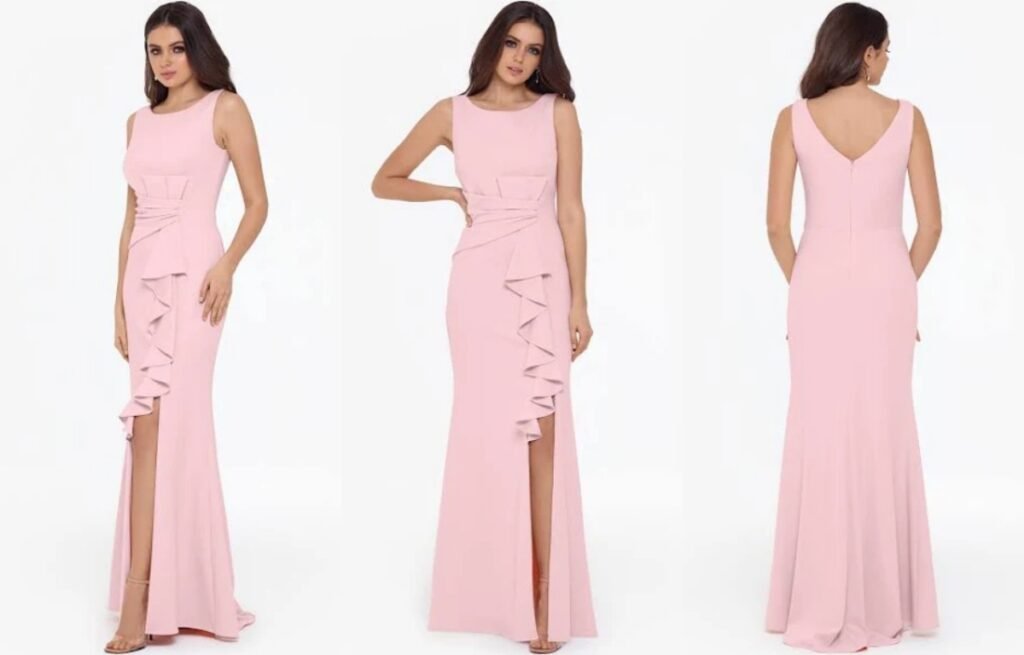
Simple yet elegant, the boat neck dress is a quiet statement of style.
A boat neck dress features a wide neckline that gently follows the collarbone, creating a graceful and balanced frame for the upper body. It evokes classic femininity and has remained a staple in refined women’s wardrobes.
What defines a boat neck dress and how does it flatter different body types?
The neckline shape is subtle, but its effect is powerful.
A boat neck (or bateau neckline) runs horizontally across the collarbone, typically stopping just before the shoulders. It draws attention upward, highlights the neck, and creates a sense of symmetry.
Many designers love this neckline because it works across various dress styles—structured or soft, fitted or flowy.
How the boat neck silhouette enhances balance and elegance
Neckline Geometry and Visual Focus
The boat neck creates a horizontal line at the top of the dress. This visually broadens the shoulders slightly, which can balance out wider hips (making it especially flattering for pear-shaped figures). For rectangular body types, it adds definition to the shoulder line, giving a more sculpted appearance.
Elegant Framing for Accessories
The collarbone exposure offers the perfect space for minimal jewelry—such as a pearl strand or delicate chain. This makes boat neck dresses ideal for occasions where understated elegance is key, like formal receptions or semi-formal events.
Posture-Enhancing Presence
There’s a subtle posture effect with boat necklines: because they rest high and wide on the shoulders, they naturally encourage straighter posture. The wearer instinctively lifts the chest, creating a more elegant presence.
Compatibility with Various Sleeve Styles
The boat neckline works beautifully with cap sleeves, 3/4 sleeves, or long sleeves. For example, a boat neck with long fitted sleeves exudes grace and modern sophistication, while short or cap sleeves keep it youthful and fresh.
Timeless Appeal Across Decades
From Audrey Hepburn’s iconic looks to Meghan Markle’s wedding dress, boat necklines have repeatedly appeared in style icons’ wardrobes. Their minimalist charm has made them a go-to for refined femininity in both casual and formal dress designs.
Body Types Best Suited for Boat Neck Dresses
| Body Shape | How Boat Neck Helps |
|---|---|
| Pear | Balances wider hips by widening upper frame |
| Rectangle | Adds shoulder definition |
| Hourglass | Maintains proportion without overexposing curves |
| Inverted Triangle | Can be used with volume at the skirt for balance |
What fabrics and dress styles suit the boat neck best?
Choosing the right fabric enhances the clean elegance of the neckline.
Structured materials like ponte, crepe, or satin highlight the neckline’s clean shape, while soft fabrics like jersey or chiffon lend a more relaxed, draped feel.
Depending on the occasion, designers often tailor the boat neck to:
- Fitted Sheath Dresses – Sleek and ideal for professional or formal settings
- A-line Silhouettes – Balanced and feminine, perfect for weddings or parties
- Maxi Dresses – When paired with lightweight fabrics, create a graceful, flowing silhouette
- Knit Boat Neck Dresses – Offer a casual yet refined everyday style
Scoop Neck Dress
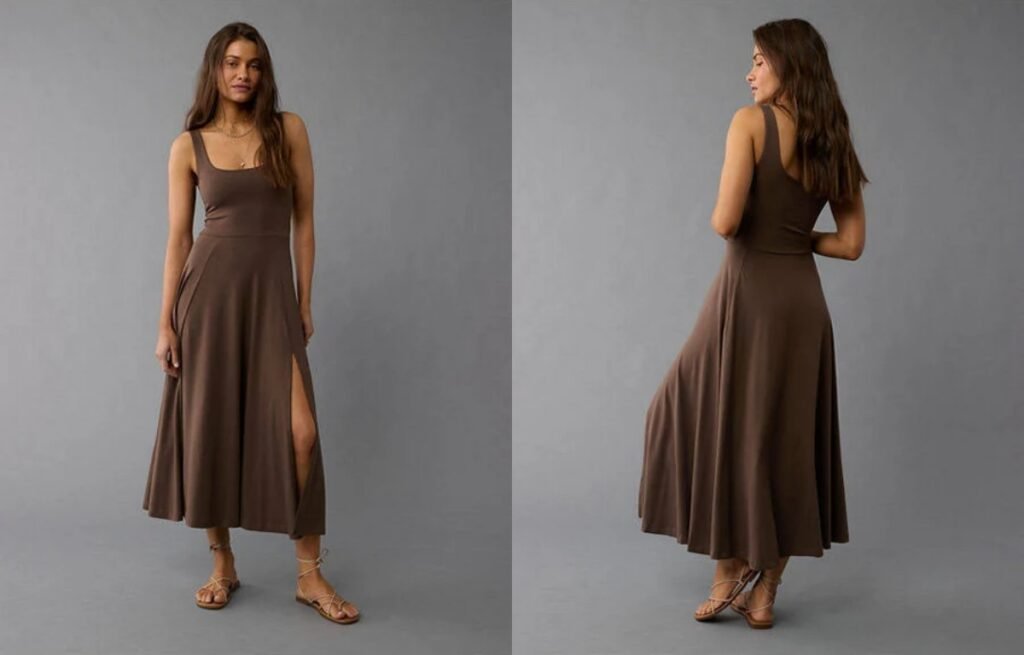
What defines a scoop neck dress and why is it a wardrobe essential?
Scoop neck dresses look simple, but their impact is anything but basic.
A scoop neck dress features a U-shaped neckline that dips below the collarbone, flattering a wide range of body types and creating a soft, feminine look. Its versatility makes it suitable for both casual and formal occasions.
I first noticed the power of this neckline when a client tried on a basic jersey scoop neck dress—it instantly highlighted her collarbones and made her entire upper body look more elegant.
How does the scoop neckline affect the overall silhouette of a dress?
A neckline isn’t just a design detail—it changes how the whole dress feels and fits.
The scoop neck draws the eye vertically and opens up the chest area, creating an elongated neckline and a balanced upper-body silhouette. It softens sharper jawlines and helps balance proportions for those with broader shoulders or a fuller bust.
Why the scoop neck dress works across body types and styles
The scoop neckline may look minimal, but it plays a major role in fashion design. Understanding its visual and practical benefits can help both designers and buyers make smarter style decisions.
Visual Balance and Proportion
The curved U-shape of a scoop neck breaks up the expanse of fabric across the chest and shoulders, creating an open frame that draws attention upward. For women with short necks or round faces, it provides visual elongation. For those with a large bust, the scoop prevents the chest from looking overly bulky, offering a slimming effect.
Body Type Adaptability
Scoop necklines work well for:
- Petite figures: Adds the illusion of length.
- Athletic builds: Softens the angles of shoulders and collarbones.
- Hourglass shapes: Accentuates the bust without adding width.
- Fuller busts: Opens the neckline and balances volume.
The key is the depth and width of the scoop. A deeper scoop can highlight the décolletage, while a shallow one maintains a modest yet graceful look.
Styling Flexibility
Scoop neck dresses come in a wide range of silhouettes—bodycon, A-line, empire waist, or maxi. The neckline pairs beautifully with accessories:
- Necklaces: From chokers to layered chains
- Layering: Works well under jackets, cardigans, or even over t-shirts
- Seasonal styling: Great for summer as a sleeveless cut, or layered in colder months
Designers often pair scoop necklines with soft, flowy fabrics to enhance femininity, but they also work well in structured materials for a more modern look.
Scoop Neck vs. Other Necklines
| Neckline Type | Visibility | Best For | Style Impression |
|---|---|---|---|
| Scoop Neck | High | Most body types | Feminine, classic |
| V-Neck | Moderate to high | Fuller busts | Sexy, elongating |
| Square Neck | Medium | Narrow shoulders | Vintage, structured |
| Crew Neck | Low | Small busts | Casual, modest |
Which fabrics and dress types enhance a scoop neckline?
Fabric choice affects how the neckline falls and feels on the body.
Lightweight and soft fabrics like jersey, rayon, modal, or silk enhance the curve of the scoop neck, while structured materials like cotton poplin or ponte offer a clean, defined edge.
For formal occasions, silk or satin scoop neck dresses bring elegance. For everyday wear, cotton or stretch blends offer comfort with style.
Recommended Dress Types:
- Bodycon Scoop Neck Dress: Highlights the figure while keeping the neckline open
- A-Line Scoop Neck Dress: A universally flattering shape with gentle flow
- Sleeveless Maxi Dress: Ideal for summer, especially in breathable fabrics
- Layered Midi Dress: Works well with the neckline and adds movement



